Blog
Archives
.
. . from 2012 to current
SATURDAY
MAY 30 - 2015
Camber
Sands
During a
family holiday I had the opportunity to have a look
around the dunes at Camber Sands in East Sussex on a
very windy afternoon and very interesting it was too.
The dunes stretched for miles and were dominated
mostly by Marram Grass and Sea Buckthorn.
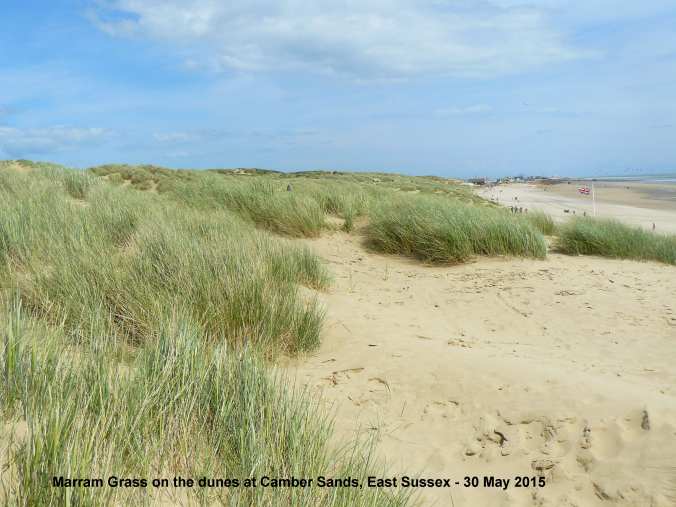
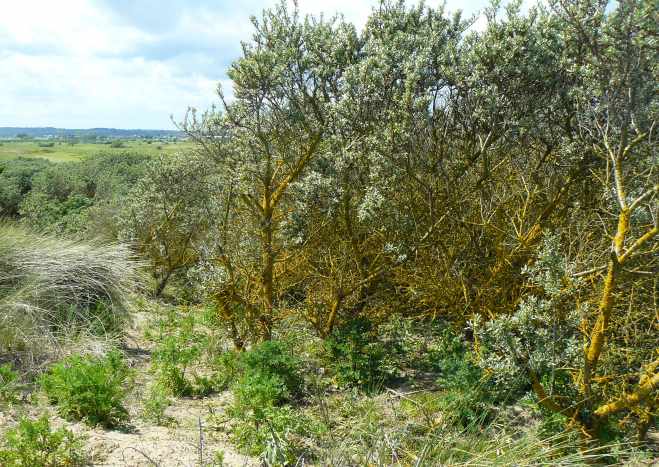
However, the best
plants were the Houndstongue of which I found
hundreds in flower in small sheltered areas of the
dunes. I have only seen Houndstongue once before - at
Northney during a plant survey with John Norton
(10-Jul-11). The plants reminded me of the common
garden Lungwort, but the leaves were plain and not
spotted. I gather from the Sussex Plant Atlas that
Camber is a particularly good place to see
Houndstongue on sand.
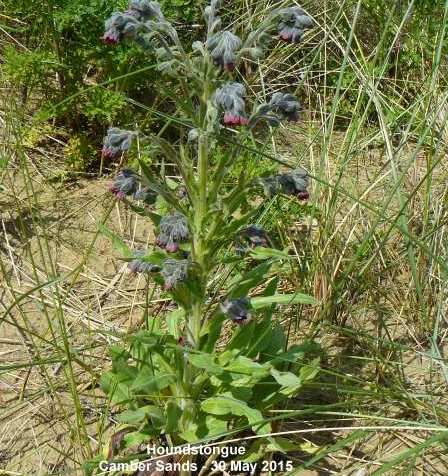
Here is a close up of
the attractive red flowers.
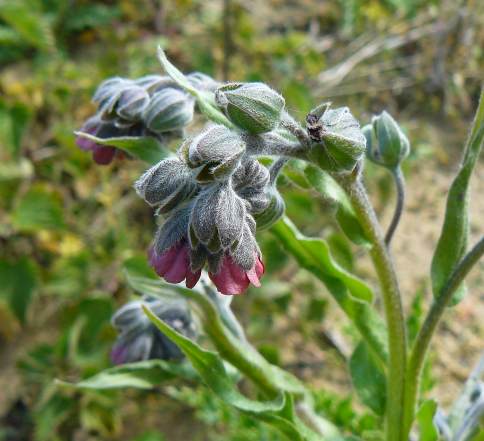
I also found some
solitary yellow daisies on thin stalks which I think
were Lesser Hawkbit, though I must admit to
toying with the idea of the very rare Smooth
Catsear.
I was also surprised to find lots of Common Ragwort
on the dunes, not in flower, of course, but
attracting Cinnabar moths, the larvae of which
feed on the leaves on Ragwort.
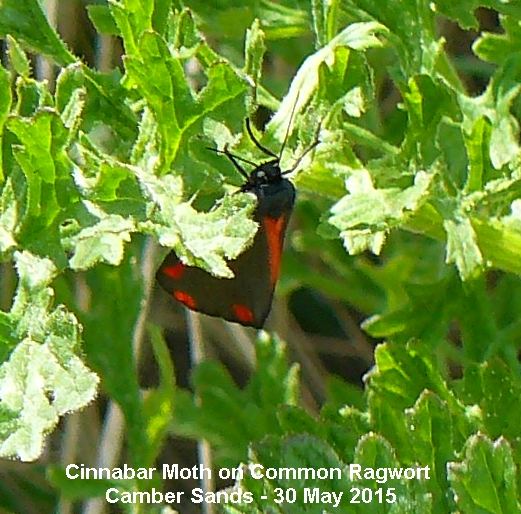
THURSDAY
MAY 28 - 2015
Bridge
Road Wayside
I did a mini
plant survey of the Bridge Road Wayside and added a
good number to the 2015 list which now stands at 87
species. The total list for the wayside stands at 194.
So there is still a long way to go. The chemical
spraying of the kerb area adjacent to the car park by
the council for the first time this year will have cut
the number of species, as I used to find quite a lot
of small stuff along that kerb.
Two observations of some interest. Firstly a very
hairy Thyme-leaved Speedwell. The guides all
say that this plant is 'more or less hairless', but
this one is certainly very hairy as shown in this
photo. CORRECTION - this was Wall Speedwell.
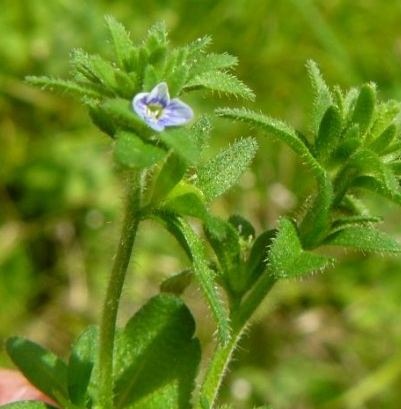
Secondly, a very small
black and yellow Ladybird which I had to look up to
identify it as a 14-spot. Apparently the wing
cases can vary from all yellow to almost all black,
with black spots merging together as in this chap in
my photo.
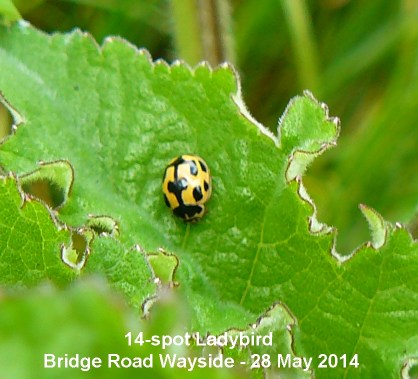
Several cut branches
from a fir tree have been left across the Westbrook
Stream in Bridge Road car park. They are partly
blocking the stream and partly jutting into the car
park. I was told by a local resident they were left
there last Monday (May 25th) following the erection of
a new fence at the end of one of the long gardens in
St James Road. The branches were clearly removed from
the tree to make way for the fence. I have informed
Rob Hill and Richard Denman of HBC about this asking
them to get the branches cleared.

More
orchids
Jennifer Rye
informed me that she found a group of 5 Common
Spotted Orchids in flower this afternoon, just
north of the new perimeter barrier that the
conservation group built last workday. Jennifer adds,
"If you start from Beryl's bench and go due west it's
about 20 paces in. I've marked it with three twigs".
That's great news, the first Common Spotted Orchids of
the year in roughly the same place as last year.
Magical
evening
Francis
Kinsella had what he described as a 'magical evening'
last night on Brook Meadow. First he had a very large
group (more than a dozen) young Long Tailed
Tits flitting round the trees by the north bridge
in the meadow. They seemed quite unafraid, coming very
close and flitting from tree to tree. Here is one of
them that Francis captured.
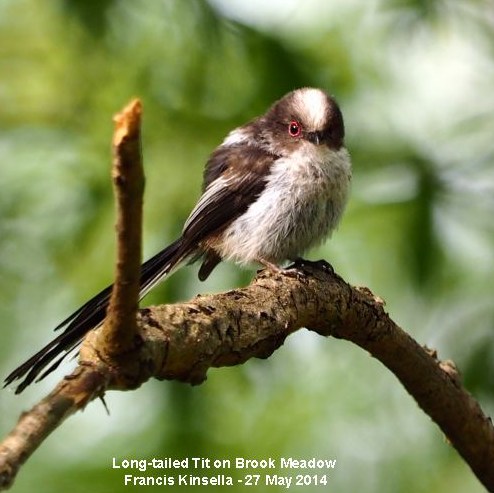
He also got a what is
probably a female Banded Demoiselle in flight.
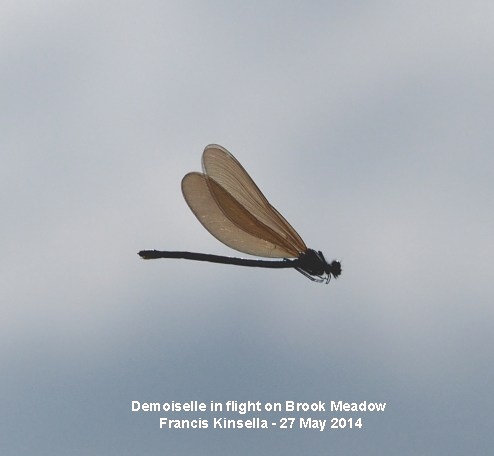
WEDNESDAY
MAY 27 - 2015
Brook
Meadow
I headed for
the main orchid area on the north meadow this
afternoon which is basically covered in yellow
buttercups, with lots of Red Clover and Yellow Rattle
just starting to flower. Here it is looking north
towards the railway line.
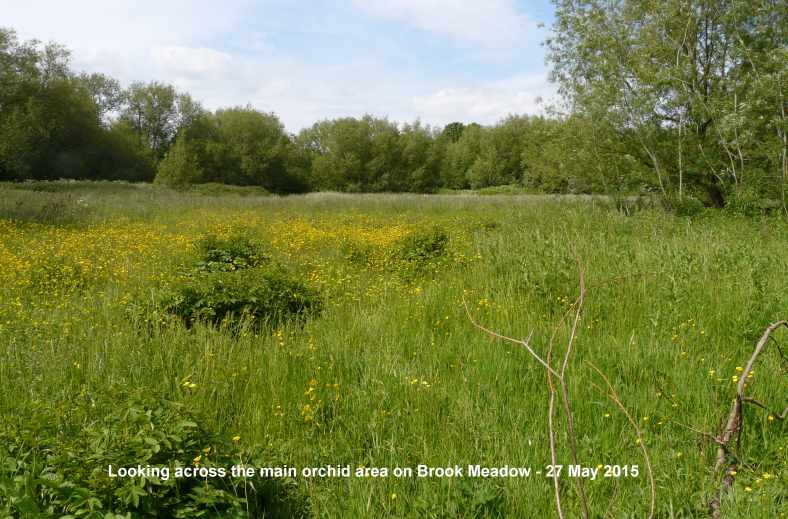
My interest was mainly
in orchids. I found that five more Southern Marsh
Orchids had come up since my last count two days
ago and so the total now stands at 15 spikes which is
a new record for the meadow. They are all marked with
small twigs.
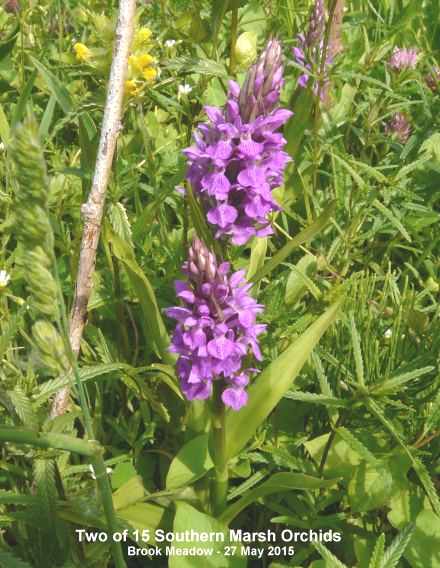
I looked around for
Common Spotted and Bee Orchids, but did not see any
sign of them. But it is early days. Newly flowering on
the orchid area were Silverweed and Hard Rush.
The Ragged Robin count is also rising slowly. I
counted 30 flowering plants on the Lumley area and
another 4 on the area above the causeway. This
relatively small number suggests this is not going to
be a bumper year. Last year the count was 104, but the
record stands at 625 in 2010.
Cuckoo
Bumblebee?
Young Thomas
Irons took this photo of an unusual Bumblebee on a
lawn in a Warblington garden.
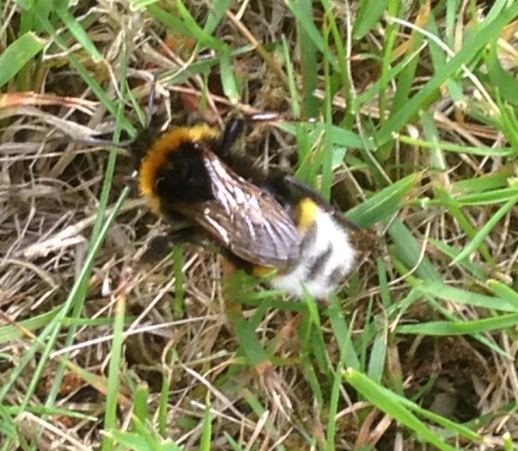
My tentative
identification is a Cuckoo Bumblebee possibly
Psithyrus vestalis - but I shall check
with Bryan Pinchen. Psithyrus vestalis, like
the insect in Thomas's photo, is mainly dark in colour
but for the prominent yellow band at the front of the
thorax and two lemon wedges on the abdomen where the
black meets the white tail.
Cuckoo Bumblebee queens emerge in May and take over
the nests of their preferred host species, in the case
of Psithyrus vestalis that would be the common
Bombus terrestris. The host queen is killed and
new eggs are laid in the nest and the host Bumblebee
workers then raise the Cuckoo young, rather like
happens with birds. Hence, there is no need for worker
Cuckoo Bumblebees and only new queens and males are
produced.
Langstone
Mill Pond
This morning
Peter Milinets-Raby paid his last visit to Langstone
Mill Pond for a couple of weeks as he is off on
holiday with the family to Belarus.
"I walked in along Wade Lane (10am to 11:50am). Great
spotted Woodpecker 2 adults at a nest hole trying to
entice out the young (see photo of young refusing to
budge),
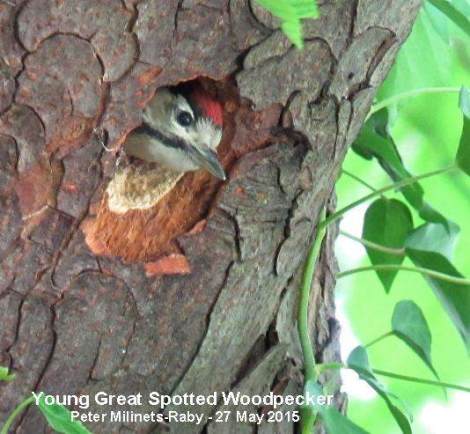
Med Gull over south, 3
Great Black-backed Gulls south, 6 Swallow, Blackcap
singing.
Langstone Mill Pond: Reed Warbler - two birds singing,
Chiffchaff singing, Cetti's Warbler singing, Reed
Bunting singing, A pair of Tufted Duck, Mute Swan pair
with seven cygnets still (see photo of female hissing
at a passing dog!). 1 Swift over - hurray!!!
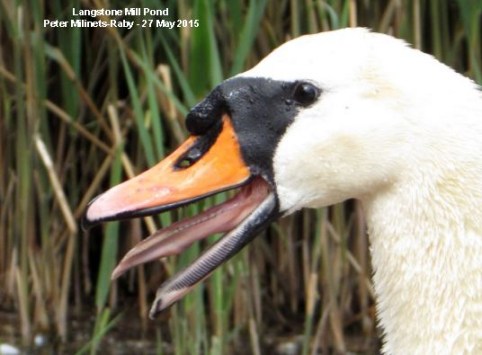
Some noises from the
Little Egrets suggesting chicks, but I could not find
any - give it another week and the place will be
heaving!!!
Off shore (low tide). Lots of mud, 3 Common Terns, 47
Herring Gull, More empty mud. 1 Oystercatcher, 1
Sandwich Tern. 5 Buzzard in spiral over north
Hayling
Foxes
in the garden
Mike Wells
responded to my request as to how my neighbour might
get rid of a family of foxes that are living (and
wrecking) his garden.
"I have had two neighbours with foxes living in their
gardens and have managed to clear both families. Are
the foxes resident in the garden? If so, and if
they're under a shed, I would find the entry area (s)
and, during the day, when they are mainly inactive,
get the garden hose on 'jet' setting and fire it in
all directions under the shed, the re-action has been
instant and quite humorous! On both occasions I let a
considerable amount of water go under both sheds so as
to make it very wet and too uncomfortable to bring up
a family. If foxes have been flushed out, they must be
kept out, and I have found that soaking kitchen roll
paper in the cheapest, nastiest after- shave or
perfume, and poking it down any entrance will
certainly make their eyes water (it did for me!) The
whole process is to make life uncomfortable in any way
so that the vixen re-locates her family without any
harm coming to them. Importantly, once the foxes have
left their home for good, it must be made impossible
for them to return under the building. Many years ago
we had foxes under our shed and I cleared them within
2 hours by pouring creosote into shallow containers,
with chicken wire stretched across the tops so they
couldn't step in it, and poked it just under the shed
and simply let a gentle breeze spread the aroma under
the shed. I don't know if creosote is still available,
because of its carcinogenic possibilities, but I'm
certain anything with a strong unacceptable smell will
still do the trick. If they are not resident in the
garden I would still support the placing of multiple
'unacceptable smelly substances' around the area that
they frequent. If the foxes move it, replace it. If
your neighbour would like a volunteer to blast water
under a garden building, I would happily do the task
for free, just for the enjoyment factor!!"
I have passed Mike's suggestions onto my neighbour who
was very grateful. He told me he had made two other
contacts about the foxes, one of which offered to
shoot them for a princely sum of £350. Mike's
ideas are far less radical and legal!
TUESDAY
MAY 26 - 2015
Millpond
News
The pen swan
was with her 6 remaining cygnets on the town millpond
near the end of Nile Street when I walked along
Bridgefoot Path this morning. Jackie-Michelle Daines
tells me the cygnet that was attacked by a Herring
Gull yesterday did not make it through the night. She
thinks it received an internal neck/spinal injury in
the attack.
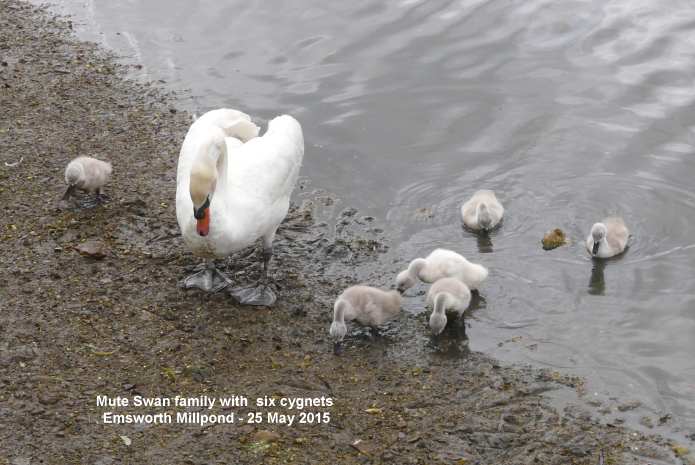
There is now a Coot
on a nest in the centre of the pond. Coot
frequently used to make nests in the centre of Peter
Pond in past years which were never successful due
mainly to rising water levels. Coot have also tried to
nest on the town millpond from time to time but never
with any success. However, with a low and stable water
level being maintained for the swans it might just be
possible.
On Slipper Millpond both the Great Black-backed
Gulls were on the centre raft with their two
chicks.
The cob swan was back on its own again on Peter Pond
after having female company yesterday.
A Reed Bunting was singing from the reedbeds to
the north of Peter Pond. Let's hope it is breeding
there.
Slender
Spike-rush
I found a good
growth of this very small sedge in the usual place on
the Lumley area of Brook Meadow at Grid Ref: SU 75133
06035. Slender Spike-rush (Eleocharis uniglumis) was
originally discovered here by John Norton on 4th June
2012. I have marked the area with a small twig. This
is probably the rarest plant on Brook Meadow!
Slender Spike-rush differs from Common Spike-rush in
having slenderer stems as shown in the following photo
of the two forms. Slender Spike-rush also only has the
lowest glume of the spikelet without a floret; in
Common Spike-rush both the two lowest glumes are
empty. This needs to be seen with a microscope.
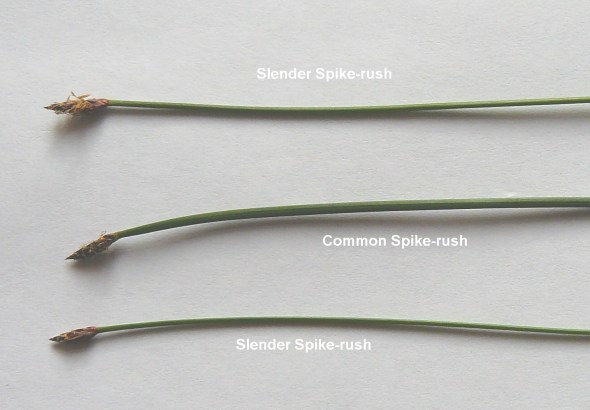
Shelduck
ducklings
Jackie-Michelle
Daines and her friend Rose spent yesterday at
Swanbourne Lake, Arundel, where they enjoyed the good
variety of ducks and gulls that can be seen on the
lake. Jackie sent me several photos she took at the
time of which I have picked out this one showing an
adult Shelduck with a 'family' of 15 ducklings.
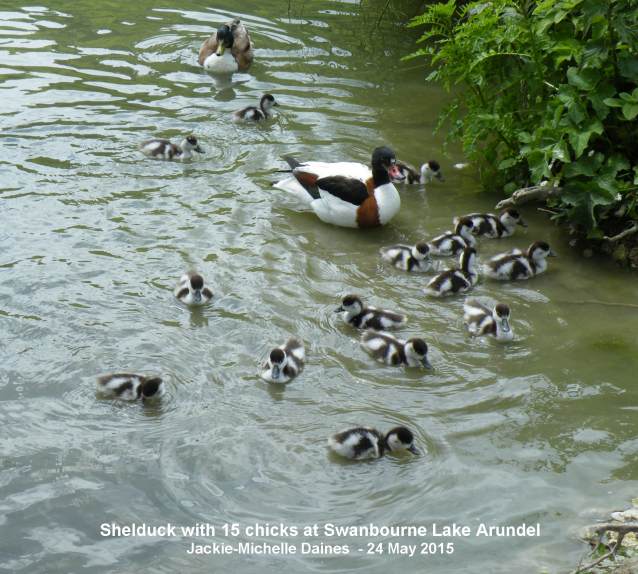
I hesitate from saying
these 15 ducklings are all part of one family as
Shelducks are well known for having crèches
where one adult looks after young from several broods.
However, I gather from the books that Shelduck can
have this number of young, though it is unusual.
Starlings
galore
What an
incredible number of Starlings there are about at
present and what a racket they make. It must have been
a bumper breeding season for them. This is good news
for a species that has declined dramatically over the
past 25 years.
I have had around 20 feeding in my garden today, most
of them seem to be youngsters begging for food and
generally squabbling among themselves. What fun they
are.
Here are
youngsters in my garden crowding on the bird table
closely watched over by dad (or mum).
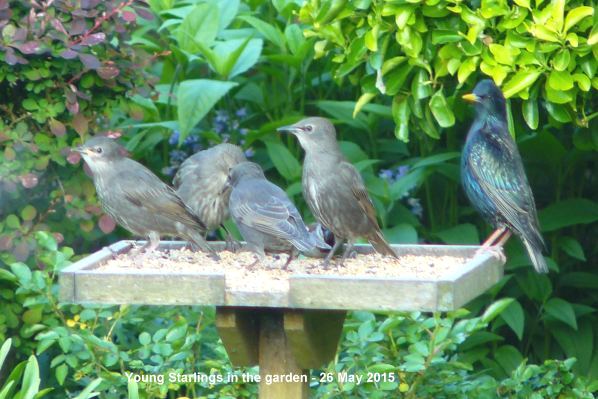
And here they are
queueing up for a drink from the bird bath.
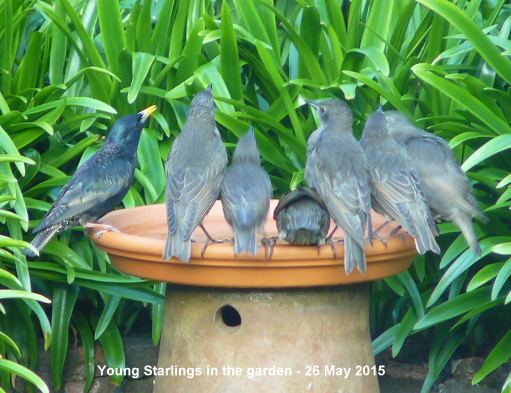
Charlie Annalls got
back from a week away to find a hoard of hungry
Starlings and youngsters in her Portsmouth garden.
This youngster looks as if it is eating the parents
face!
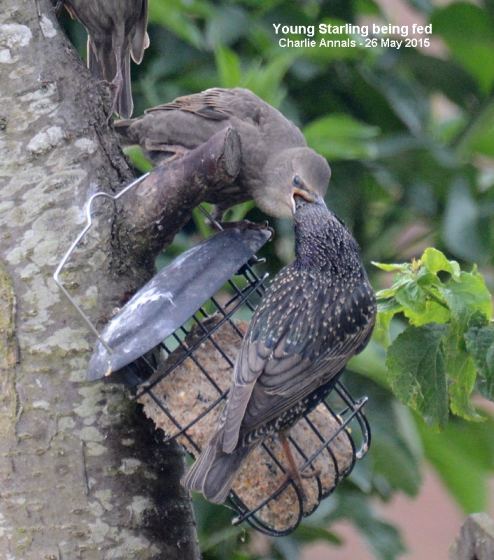
Family
of Foxes
I had a phone
call from a neighbour in St James Road to say they had
a family of Foxes in the garden which were damaging
the garden and which they would like to get rid of. I
had no idea what to suggest apart from giving Havant
Borough Council a ring to see if there was someone in
the pest control section who could suggest a solution.
Has anyone had any experience of having foxes in the
garden?
MONDAY
MAY 25 - 2015
Cygnet
attacked
All was well
on the town millpond when we walked past at about 11am
this morning; the Mute Swan pair were with their 7
cygnets near the bridge. However, things changed
dramatically this afternoon. Jill Lovett e-mailed me
to say she witnessed a gull attacking one of the seven
cygnets at about 3pm. Jill said bystanders drove the
gull away and the cygnet was rescued from the water by
a local lady who took it away. This was the second
cygnet on the millpond to be attacked by a gull; the
previous incident happened on May 19th when one of the
pale 'Polish' cygnets was the victim.
I went to have a look for myself at 6.30 this evening.
The pen swan was on the mud near the bridge preening
with the remaining six cygnets around her as if
nothing had happened. Swans, like other birds do not
grieve like humans. I was half expecting to see the
other 'Polish' cygnet missing, but it was present, so
one of the 'normal' cygnets must have been the victim
of today's attack.
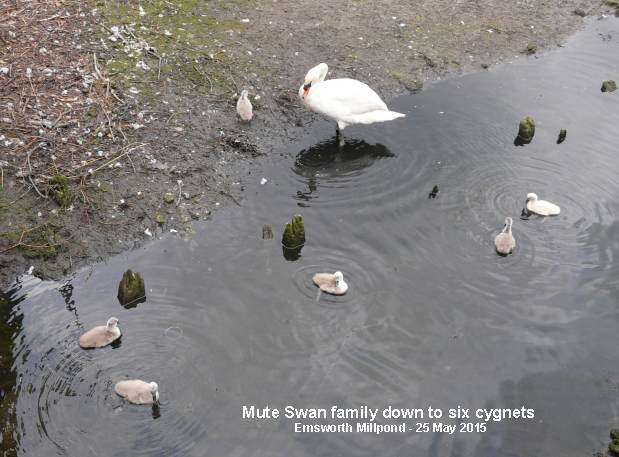
I spoke to Glynis
Irons while I was at the pond and she told me that the
attacked cygnet was still alive and was being 'nursed'
by Doreen, a local resident who takes a special
interest in the swans on the millpond. The intention
is to return the cygnet to the pond if it recovers.
Glynis kindly provided me with a photo of the little
cygnet snug in a box.
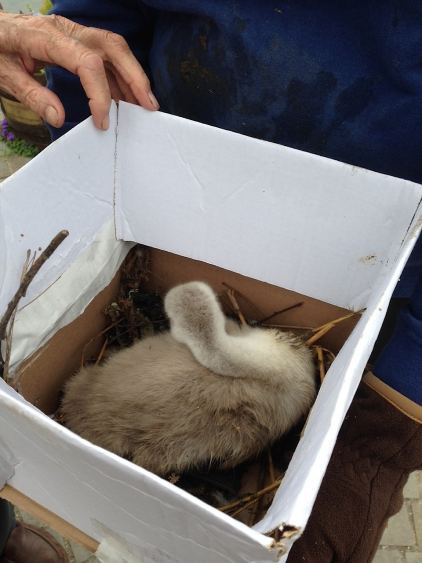
Great Black-backed Gull chicks
Much better
news over on Slipper Millpond with the arrival of the
first Great Black-backed Gull chicks of the
year. I have been expecting them to hatch any time,
though I did not get down to see them yesterday.
However, this morning the two parents were on the
centre raft busily feeding two healthy looking chicks
with regurgitated food. The chicks looked quite well
developed, so I assume they have been out for a day or
two.
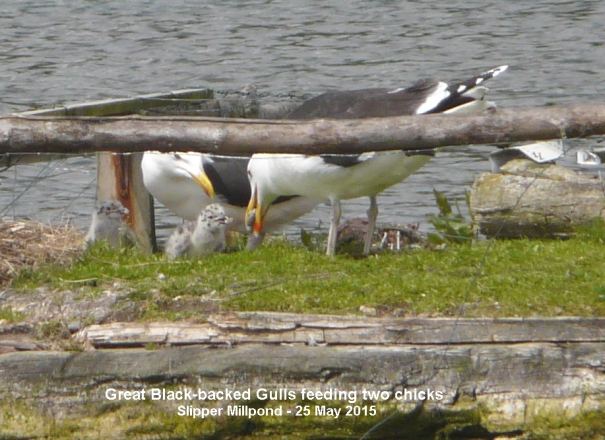
The lone Mute Swan
cob was on the pond near Chequers Quay with his
'new mate'. Three Swallows were feeding over
the pond.
The Tree Mallows are now in full flower around
Slipper Millpond and look fine with their bright pink
flowers. Also, in flower, but less conspicuously was
the Sea Club-rush along the western side of the pond.
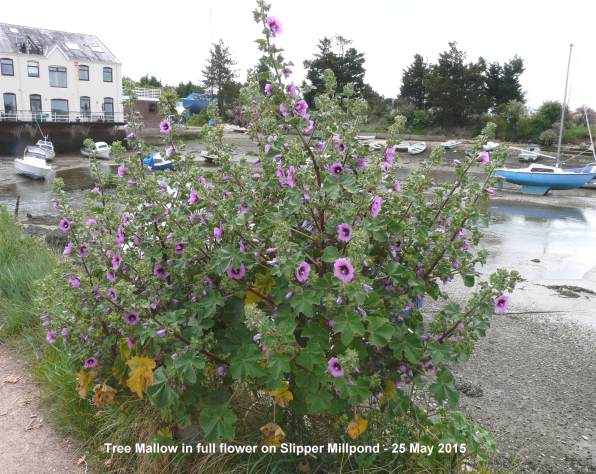
Brook
Meadow
Coming back
through Brook Meadow we met Jill Stanley taking photos
of wild flowers. Jill is a fairly regular contributor
to this blog and so I invited her onto the main orchid
area which now has a twig barrier to prevent casual
access to this sensitive area. She was delighted to
see the Southern Marsh Orchids doing so well,
though they still have some time to go before they
reach full flowering maturity. However, we did find
another two flower spikes taking the total for the
year so far to ten! I wonder if we shall get some more
and break this record?
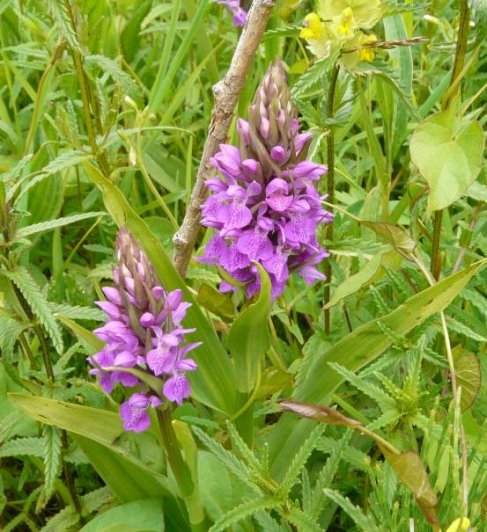
Walking back towards
the north bridge along the north west path we came
across a brightly coloured Small Copper
butterfly fluttering around the vegetation. It finally
came to rest allowing me to get a reasonable photo.
What a beautiful butterfly this is. I always seem to
see Small Copper along this path each year. Maybe, we
should think about renaming it as 'the Small Copper
path'. Our last sighting on Brook Meadow was on May 4
by Malcolm Phillips.
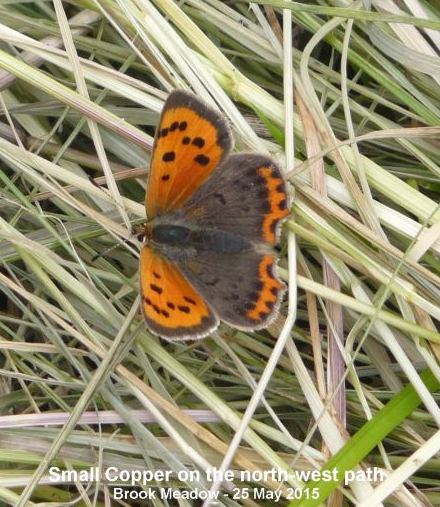
Garden
birds
Things seem to
be picking up in the garden on the bird front after a
few weeks of relative quietness. Today I recorded 2
Goldfinches, 3 Starlings, 2 House Sparrows, 3
Greenfinches (first for 7 weeks), 4 Collared Doves, 3
Woodpigeons, plus 2 Jackdaws (very unusual). I was
also pleased to see the return of a Rook filling its
crop with seed and chopped peanuts from the bird table
and a male Great Spotted Woodpecker digging into the
sunflower hearts after 10 weeks absence.
Columbine
or Aquilegia
I had a gentle
ticking off from Ralph Hollins about referring to the
colourful array of flowers I found on Portsdown Hill
yesterday as 'Columbines'. Ralph referred me to the
distrubution map in The Hants Flora that shows no
records for the native Columbine for SU 60 or SU 70
whereas Garden Aquilegia has always been fairly common
as a garden escape in our area. He says, Martin Rand
would want to discourage the use of the name Columbine
unless one is sure it is the native version. Point
taken.
Spiderlings
Ralph Hollins
also provided information about the mass of
spiderlings that Chris Oakley found in his garden
yesterday. Ralph think they are the young of the
common Garden Cross Spider (Araneus
diadematus). You can see further confirmation of
the id at . . . http://www.nicksspiders.com/nicksspiders/araneusdiadematus.htm
SUNDAY
MAY 24 - 2015
Portsdown
Hill
Jean and I had
an interesting walk along the slopes of Portsdown Hill
below Fort Widley this morning. Of course, we enjoyed
the great views over Portsmouth to the Isle of Wight,
but there was also much of interest right under our
feet with a glorious variety of wild flowers typical
of this chalk grassland. These included Wild
Mignonette, Salad Burnet, Crosswort, Oxeye Daisy,
Bird's-foot Trefoil, Red Campion, Bladder Campion,
White Campion, Goat's-beard (not open) and Glaucous
Sedge. Upright Brome was the major grass of the area,
though I also found some Quaking Grass just starting
to flower. A number of Rough Hawkbit flowers were
dotted around. They are tall yellow daisies with long
very hairy stems and leaves only in a rosette at the
base.
Left
to right and top to bottom:
Salad Burnet, Bladder Campion, Quaking Grass, Rough
Hawkbit.
I was surprised at the
abundance of Common Gromwell on this slope which I do
not recall having seen here before.
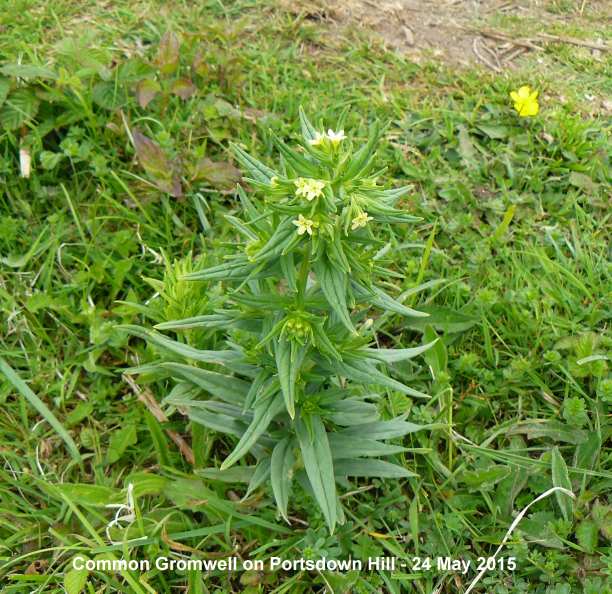
We also came across a
large patch of flowering Columbine with flowers
of many colours. My first inclination was to put this
down as a garden escape or, more likely, the product
of seeds deliberately sown. However, I gather from The
Hants Flora that Columbine is also native in the New
Forest and on chalk, so could these plants be native?
See
Ralph Hollins comment on the following day's entry.
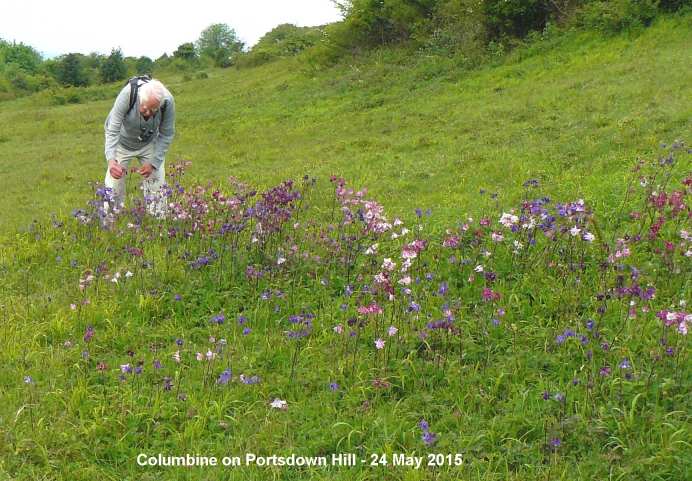
Wild Thyme was
flowering on the slope west of the fort. Lots of
Cowslips were going over behind the fort, but no sign
of any orchids.
Pike
in river
Malcolm Smith,
the owner of the camera in the river in yesterday's
blog report, sent me a still from the video that he
got showing a unique close-up of one of the Pike that
we currently have in the river. What a fearsome beast!
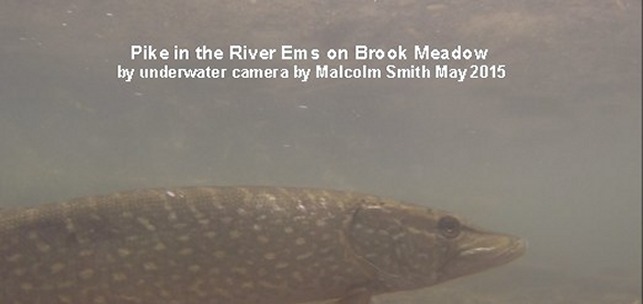
Hampshire
Farm
Chris Oakley
had a quick trip over to the pond and reports as
follows:
"I was pleased to see that several of last years
plants are thriving, in particular the Zig-zag Clover,
Celery-leaved Buttercup and Sheep's Sorrel. The Yellow
Rattle is abundant and this year has spread out of the
pond compound, under the fence and along the
ditch.
The Willow sticks are back in the water despite my
replanting them, but curiously, where they have lain
on the algae mat they have begun to shoot. The roots
are long and white reaching into the sediment, so I
have high hopes that they will prosper after
all.
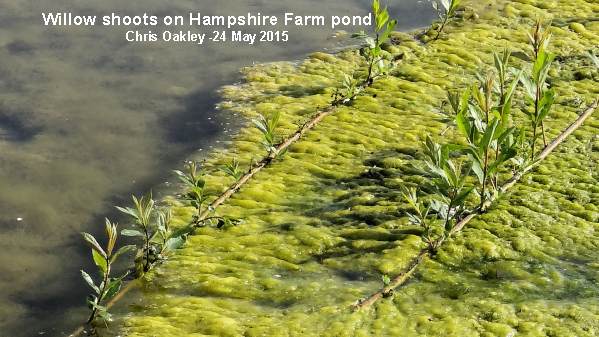
The Shelduck are still
present but I haven't been able to see if they are the
ones that appeared last month. The Mallard were there
as well. There were no sign of Dragonflies and I did
wonder if the blanket algae may have inhibited them
from hatching, or the ducks have been feeding on the
larvae.
In my garden I found a lovely clump of Spiderlings. It
always fascinates me the way they scatter when
disturbed then reform into a ball. I can't be sure
which these are but my guess is a form of Crab Spider
because of their yellow and black.
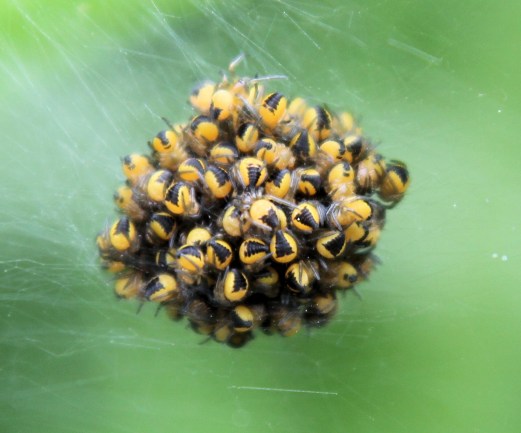
Warblington
shore
Peter
Milinets-Raby was out for 'a not very exciting visit'
to the Warblington shore (6:38am to 9am - low tide).
The birds of note were as follows: "Goldcrest singing
in Yew Tree in the church cemetery. Ibis Field:
Whitethroat, Chiffchaff singing.
Conigar Point: 2 Skylark in the field behind the point
- one singing for a short period, Cetti's Warbler
heard, Reed Warbler heard. Three heard - two in mini
reed bed and one 60 metres away along the hedgerow, 13
Long-tailed Tit, Chiffchaff singing.
1 Oystercatcher, 51 Herring Gull - non breeding birds,
2 Little Egret, 3 Common Tern, 2 Shelduck, 2 Curlew, 2
Great -Black-backed Gulls.
Pook Lane: 25 Herring Gulls, 1 Great Black-backed Gull
(adult & sub adult), Lesser Black-backed Gull (sub
adult), 5 Oystercatchers - no more waders around - the
shore is now virtually empty!!! 2 Red Breasted
Merganser (a female and a moulting male), 2 Linnets
(see photo), 1 Little Tern, 1 Shelduck.
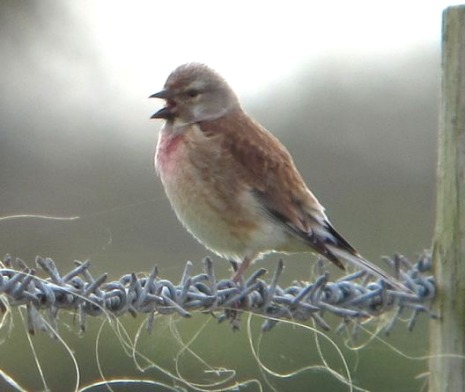
Langstone Mill Pond:
Mute Swan family left again at 7:40am with 7 cygnets
and headed across the mud to the Hayling Bridge. 5
Swallow over, Cetti's Warbler Heard. Reed Warbler - 4
pairs holding territory (see photos),
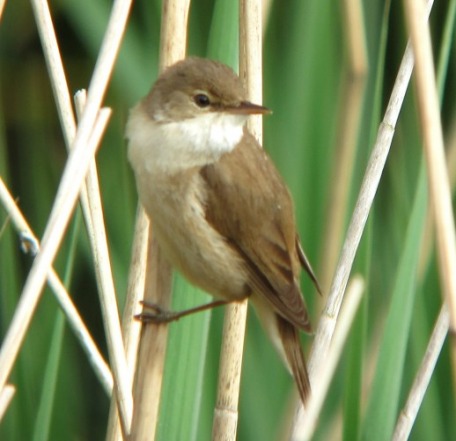
7 male Tufted Ducks
attacking and mating with 2 females - very aggressive
orgy! Mallard pair with a single duckling - a few days
old, 2 Coot families - one with two chicks and one
with four chicks, Moorhen family with 2 chicks.
Grey Heron colony, Fifth nest - 3 young, Sixth nest -
3 young. Reed Bunting male singing.
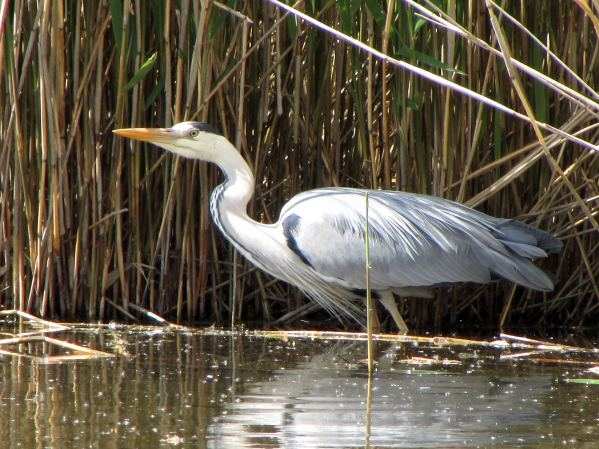
Is it me, or has this
been a very dull spring/summer. Very few summer
migrants. In general, whilst driving around teaching I
have seen very few Swifts and only one or two House
Martins."
I agree with Peter, I have seen only 4 Swifts over the
houses in Emsworth and those very briefly. And not a
single House Martin - though I would do a dance if I
did see one. But Swallows are certainly about.
SATURDAY
MAY 23 - 2015
Millpond
News
The Mute
Swan family on the town millpond continues to
progress well. When I passed by at about 11am this
morning the cygnets were feeding both from the surface
of the pond and by upending in the shallow water.
Meanwhile, the waiting
game continues over on Slipper Millpond. The Great
Black-backed Gull was still on the nest when I
looked this afternoon with no sign of any chicks.
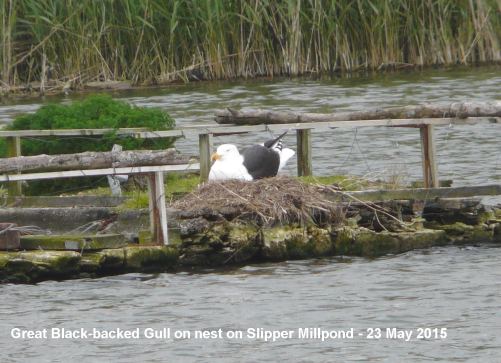
Fish
video
Walking over
the south bridge I came across a chap dropping morsels
of bread into the river for the Brown Trout to come up
for. We had a chat about the fish and he told me he
had also seen several Pike in the Palmer's Road Copse
stretch of the river.
While we were talking a couple of fellows came up with
various bits of camera equipment. They told me they
were making a video film of fish in the river for a
local camera club competition and pointed out a
water-proof camera which they had positioned in the
river just north of the bridge.
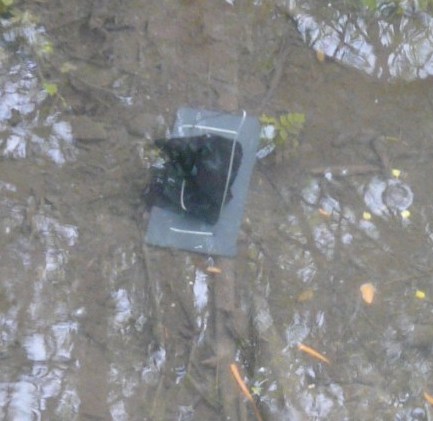
I have never seen
anything like this on the meadow before. They went off
to the car park leaving the camera in the river which
I thought was very trusting. I just hope none of the
conservation group came along and cleared it thinking
it was litter!
Procumbent
Pearlwort
We have a pot
of garden lilies in the garden which I noticed today
is covered with Procumbent Pearlwort. This leafy plant
also regularly invades the rose bed in our front
garden, much to the dismay of my wife (the rose
gardener). The plant is invasive and is not loved by
gardeners but is nevertheless a delightful native wild
plant to be cherish by naturalists.
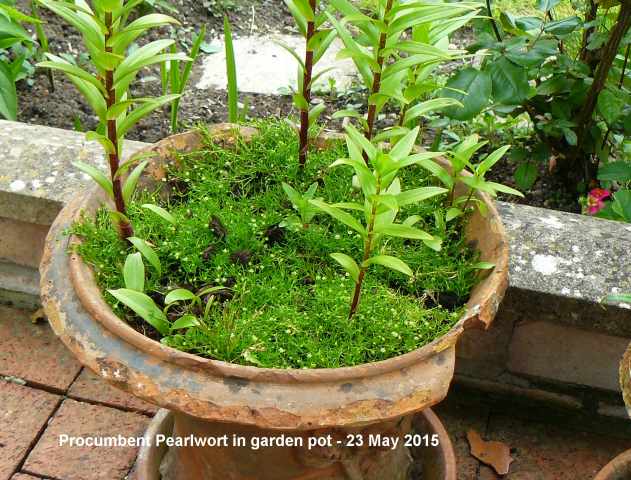
Procumbent Pearlwort
(Sagina procumbens) is a low, hairless
mat-forming plant spreading outwards from central leaf
rosette, and rooting at the nodes. Flowers are
solitary at the end of long slender stalks with 4
parted petals, minute or absent. Fruit with spreading
sepals. It basically resembles a rather leafy moss
with tiny white flowers.
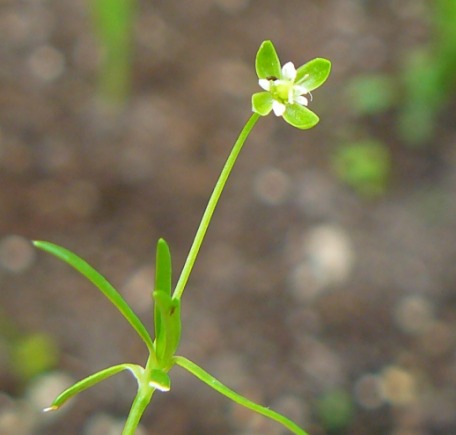
This plant loves bare
and well trampled ground, paths, walls, rocky places
and also on lawns and garden flower pots! It is a
native plant and perennial and fairly common
throughout Britain. The word 'pearl' refers to the
shape of the seed pod or unopened flower bud, while
'procumbent' simply means growing along the
ground.
Procumbent Pearlwort has a dramatic role in religious
legend as it is said to have been the first plant on
which Christ set forth his foot when he arose from the
dead. It was also thought to protect domestic animals
from fairies. It was said that a young maiden could
attract her lover by drinking an infusion of the plant
and if a piece were in her mouth when she kissed him,
he would be bound to her for ever! So, please think
twice before you pull up this somewhat rampant 'weed'.
FRIDAY
MAY 22 - 2015
Millpond
News
All was well
on the town millpond at about 2.30 this afternoon
where the pen swan was with her 7 cygnets, all looking
good and growing fast. The cob was patrolling further
down the keeping the other pair of swans at bay.
No change in the situation on Slipper Millpond where a
Great Black-backed Gull continues to sit on the nest
with its mate on the water nearby. I am way out again
on my predicted hatching date for the eggs.
The cob swan was alone on the pond, so clearly there
is not an established pairing as yet.
Peter
Pond plants
I did not
intend to stop at Peter Pond, but I got hooked when I
saw the plants coming up on the newly seeded area on
the east bank. They included a variety of wild plants
which were certainly not among the seeds, such as,
Lesser Swine-cress and Spear-leaved Orache.
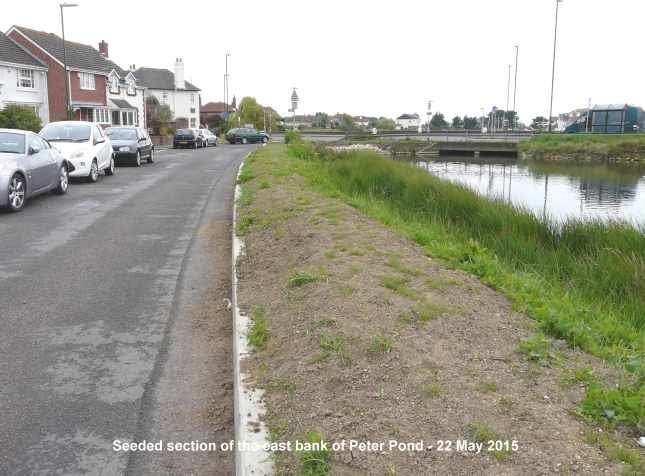
I proceeded to walk
along the east and south banks, listing all the
obvious plants that I could identify. My total plant
list for the survey came to 67. I am sure I missed
some and others will be more obvious later in the
year, so I shall need to keep this survey going.
Most interesting were
a couple of Celery-leaved Buttercup plants with
their distinctive rugby ball-shaped seed heads pusjing
their way through a tangle of other plants on the bank
immediately opposite the pull in to Lumley Gardens.
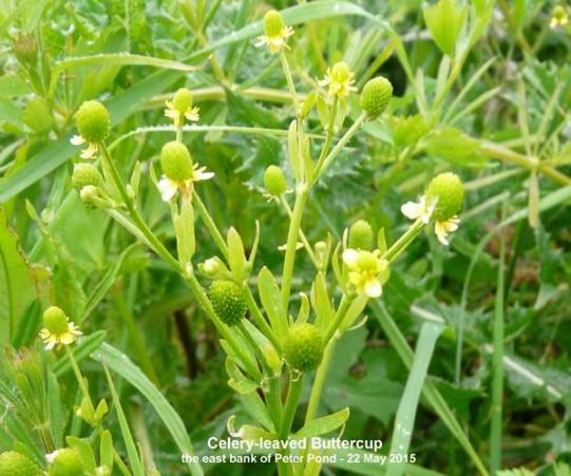
Brook
Meadow
Walking back
over the south bridge I noticed a single Greater
Periwinkle (?) flower on the east side of the
bridge. Amazingly, this was the first time it had been
recorded on the Brook Meadow site!
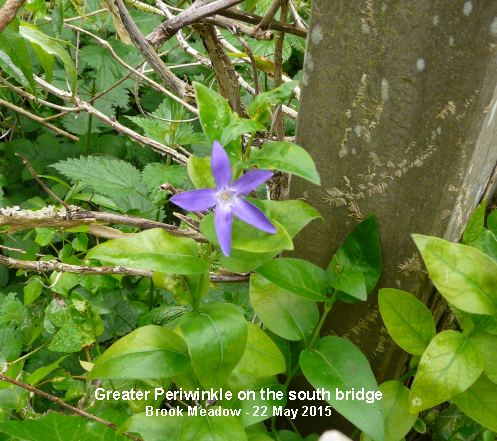
Judas
Tree
Jean and I had
a walk around Stansted Arboretum this morning in light
drizzle. The paths were being cut and it was wet
underfoot. No special observations of wildlife, though
we were interested to see Michael Prior's notice in
front of a Judas Tree in flower which had been
nominated as 'tree of the month'.
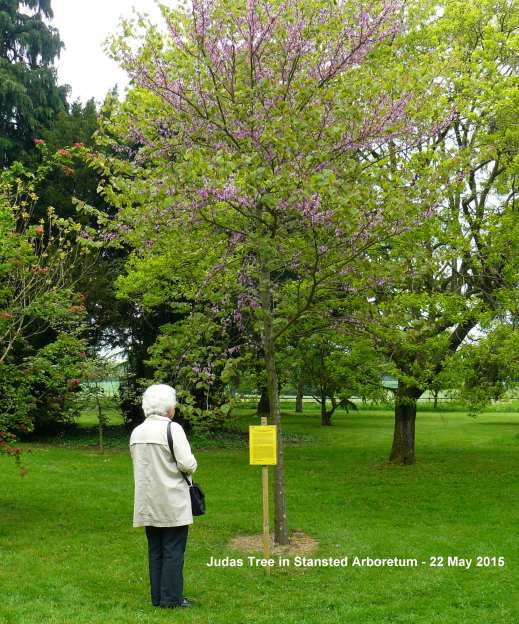
The Judas Tree is
so-called as Judas Iscariot supposedly hanged himself
on one although there are several other trees with
this claim to fame. The tree originates from SE Europe
and western Asia, but has been cultivated for
centuries in Europe. It is a favourite garden tree
mainly for its bright purplish-pink pea-like flowers
in early summer.
THURSDAY
MAY 21 - 2015
Millpond
News
The Mute Swan
was with her 7 cygnets when I passed the town millpond
today. All looking well.
Down on Slipper Millpond a Great Black-backed Gull was
sitting on the nest with no clear sign of any hatching
having taken place, though the gull was sitting with
its tail sticking up which I thought was a bit odd.
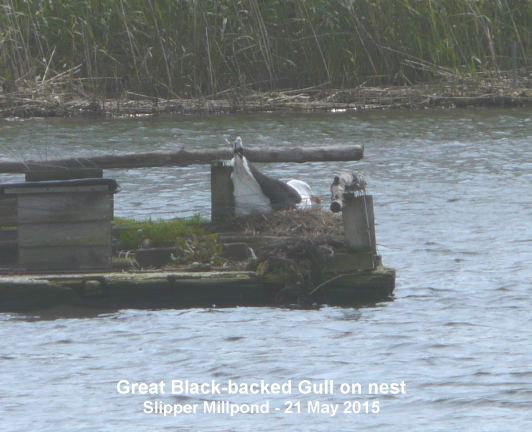
Brook
Meadow
I went over to
Brook Meadow on a fine morning for the regular
Thursday conservation work session led by Mike and
attended by 14 volunteers. The main task was to erect
temporary twig barriers around the main orchid area on
the north meadow to protect the delicate plants from
casual walkers. Notices were all placed at selected
points asking walkers not to enter the area during the
flowering season to avoid damaging delicate plants.
Here is Mike erecting one of the notices. Jennifer Rye
found another small Southern Marsh Orchid flower
spike, making 8 in total.
Volunteer
erecting notice asking people not to walk on the wild
flower area
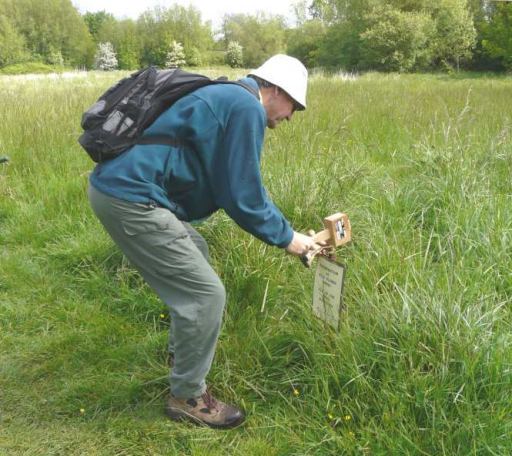
Beautiful
Demoiselle?
While we were
having coffee break at Beryl's seat during the work
session, Tony Wootton pointed out a damselfly
fluttering around on the vegetation. I managed to get
a few shots of what Tony and I thought at first was a
female Banded Demoiselle. However, looking closely at
the photos I am inclined towards a female Beautiful
Demoiselle mainly on the basis of the insect's broad
brown wings; in the female Banded Demoiselle the wings
would be narrower and have a greenish tint.
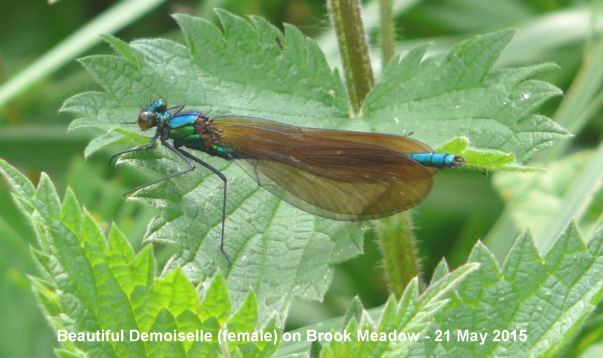
There are photos of
Beautiful Demoiselles on the internet which closely
match the one I took. However, I am not entirely
confident as looking through the previous records we
tend to see the Banded Demoiselles at this time and
the Beautiful Demoiselles a bit later in the season.
Here
is a female Beautiful Demoiselle from the internet
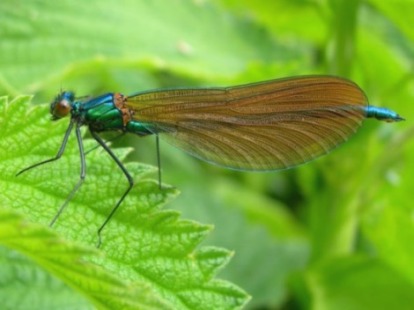
Butterflies
Being such a
fine and warm spring day, I was hoping to see some
good butterflies, but the only ones (apart from
unidentified whites) that I saw the whole morning were
a Green-veined White feeding on flowers of Yellow
Rattle and several Holly Blues, including this one on
Hemlock Water-dropwort.
Moths
While walking
around the orchid area I spotted at least two more of
the small white moths that Tony Davis identified as
Grass Rivulets - their larvae feed on Yellow
Rattle.
I saw another very small but far more colourful moth
on the south meadow which I was able to identify for
myself as I have seen it many times in previous years
both on the meadow and in gardens. It is a micro moth
called Pyrausta aurata It has two
generations in May and June and again through July and
August. It flies both during the day and at night. The
larvae feed on mints hence its common name of Mint
Moth, though it will not find many of these of Brook
Meadow.
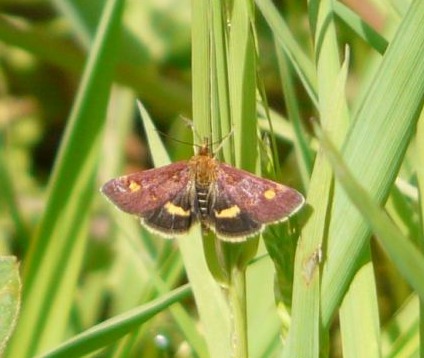
Nore
Barn Woods appeal
Mike Thomas of
the Friends of Nore Barn Woods is looking for our
support in the completion of the Shoreline
Conservation Project to protect the woods from coastal
erosion. The aim is to raise about £14k to
complete the job and the group have an opportunity to
win a £10,000 donation from Aviva Insurance
Company. The following link fully explains the project
and what they hope to achieve . . . https://community-fund.aviva.co.uk/voting/Project/View/1208
In a nut shell, they have to win as many votes. All
you have to do is follow the above link, register and
then transfer all 10 votes to the FoNBW (Friends of
Nore Barn Woods). Mike stresses this is not an appeal
for funds, there is no commitment to make a donation.
It would help enormously if you could forward the
above request to your friends, relatives or anyone
else willing to register and vote for our cause.. The
more support the better our chances of being awarded
£10,000.
30
Days Wild
On his current
wildlife diary Ralph Hollins gives a plug for a new
scheme called '30 Days Wild' run by the national
Wildlife Trusts which aims to get people (particularly
children) to interact with wildlife. The idea is to
get people out of doors on every day in this coming
June to do something in the natural world in whatever
way interests them. You can sign up for this project
on the web site and they will send you a starter
pack.
Go to . . . http://action.wildlifetrusts.org/ea-action/action?ea.client.id=1823&ea.campaign.id=37961
Ralph goes a step
further to suggest a comprehensive plan to keep you
going after the end of 30 days to stimulate an
interest in wildlife to last a lifetime. For details
on this go to . . . http://ralph-hollins.net/Diary.htm
for Wed 20th May.
WEDNESDAY
MAY 20 - 2015
Millpond
News
The pen Mute
Swan was on the town millpond at 10.15 this morning
with her 7 cygnets, having lost one of the pale Polish
ones yesterday. The remaining cygnets looked fine and
healthy and were feeding busily near the
interpretation board.
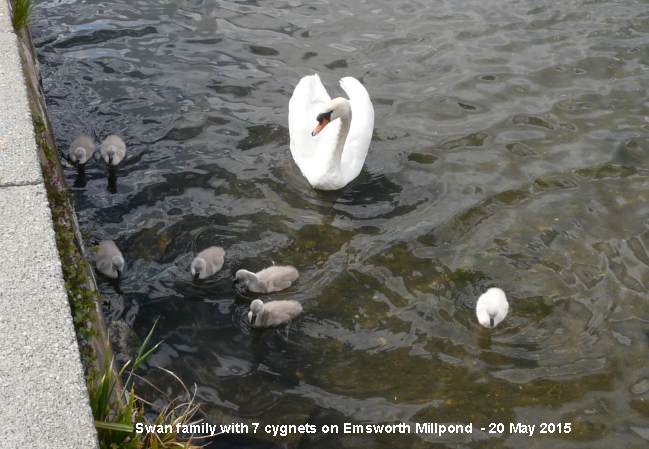
The second pair of
swans was also on the pond, but keeping their
distance, thanks to the cob patrol. What looks like a
makeshift Coot nest is out in the centre of the pond,
but with no Coot sitting.
I checked the Great Black-backed Gull nest on
Slipper Millpond, but there was no change. No sign of
any chicks as yet. However, the new Mute Swan pair
were together on the pond, which is good news.
Brook
Meadow
I had a short
walk around the meadow before the river survey.
Gipsywort with its distinctive toothed leaves
is growing well in the same place as last year, on the
west bank of the river in Palmer's Road Copse. Also
abundant on the same area are Hemlock Water-dropwort,
Water Mint and Great Willowherb.
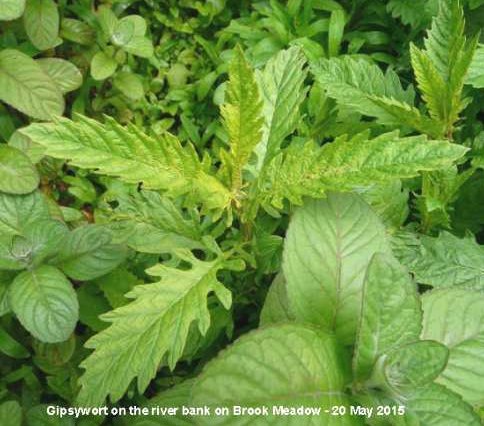
Stream Water-crowfoot
is now in flower in the river near the old
gasholder.
I happened to meet Pip and Dot Warren and friends
walking through the meadow. We went over to look at
the Southern Marsh Orchids and while we were
there we found another four flowering plants, making 7
in all. The flowers are all very small at present, but
should grow well over the next week or two. All the
orchids were marked with twigs.
I found the first Cut-leaved Crane's-bill
flowers on the main river path south of the north
bridge.
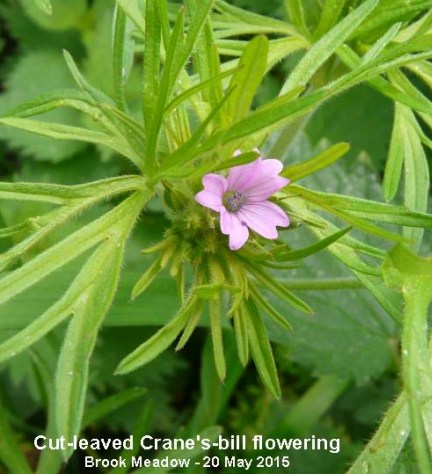
I watched a pair of
Blue Tits going in and out of a nest site in a
small cleft in the bark of one of the large Crack
Willow trees that has been pollarded just north of the
north bridge. The Blue Tit is standing right next to
the nest hole in the photo.
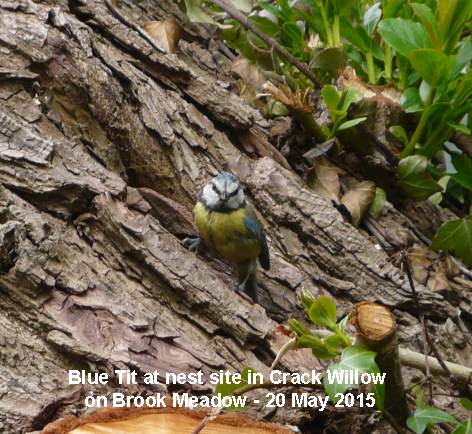
River
survey
From 11.30 to
13.30 four members of the Environment Agency, led by
Phil Rudd, carried out a survey of fish along a 100
yards stretch of the River Ems on either side of the
north bridge. Jennifer Rye and myself were present
throughout the operation. Here they are at the north
bridge getting things prepared.
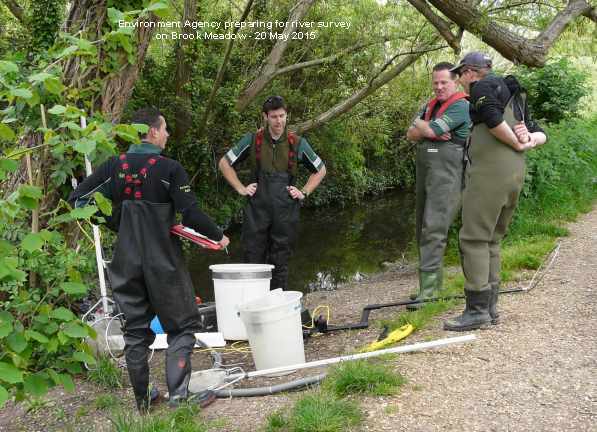
Their method was to
move along the river with an electrical device which
temporarily stunned the fish. Here they are working
below the north bridge with Jennifer watching. Both
Jennifer and I found the whole operation fascinating
and we learned a lot about fish.
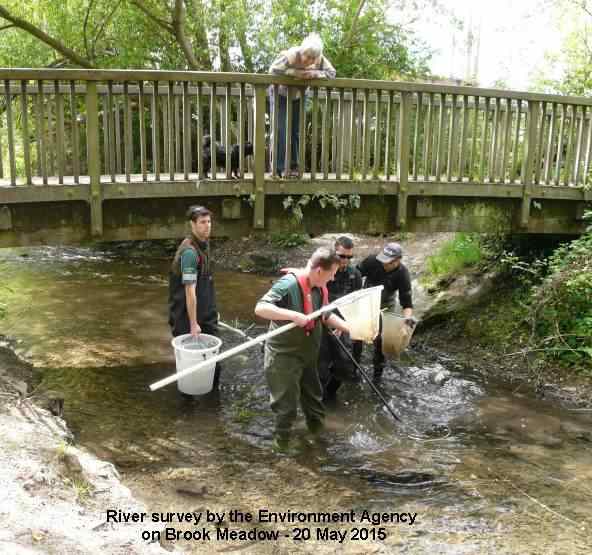
The fish were then
scooped up into a large bin for identification and
measurement. The fish were all revived with oxygenated
water and were all put back into the river.
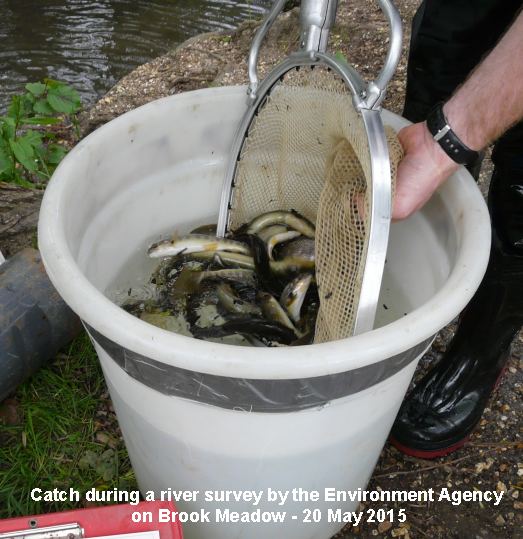
The results: Brown
Trout 46, Eels 16, Salmon 1, Bullhead 50.
Unfortunately no Pike were caught during the survey.
These are generally seen futher south near the south
bridge.
Brown Trout
count was considerably more than the last count on
Brook Meadow. They varied considerably in size from
tiny ones no more than 5cm in length which would have
been born this year,
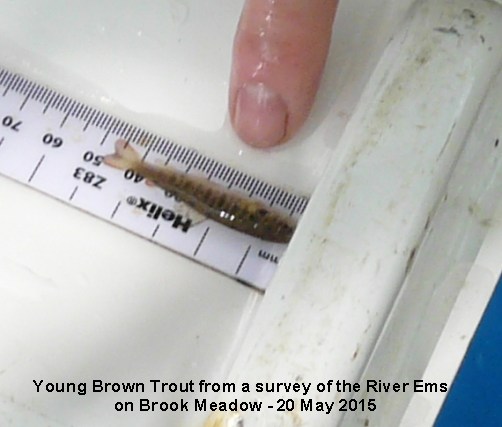
to medium sized parr
of about 13cm
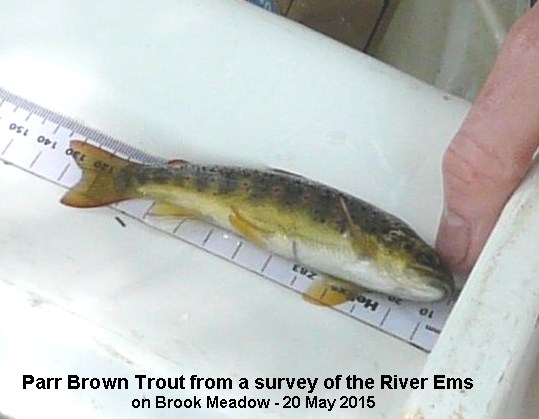
up to magnificent
mature ones of over 30 cm which would be at least two
years old. Most of the ones caught were of parr size.
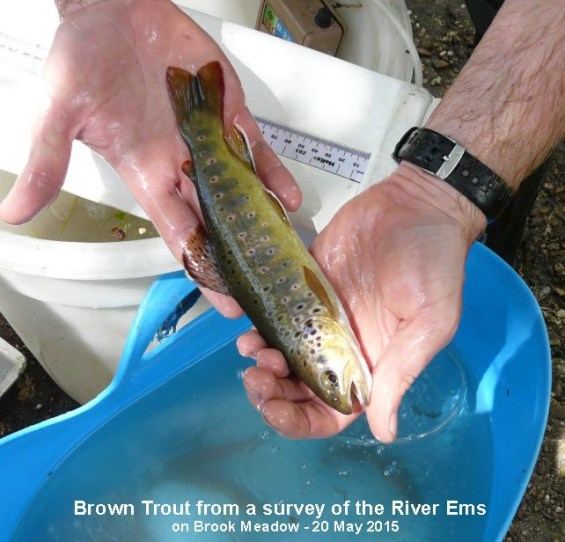
Eels also
varied considerably in size with large ones of 50 cm
and more which were probably up to 20 years old. They
will have spent all their lives in the river until
maturity and then will move out to sea again.
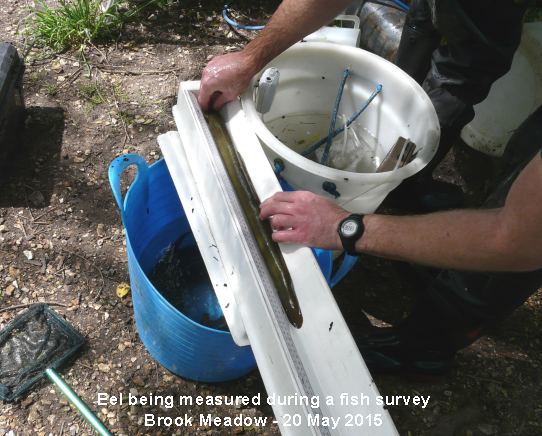
The Salmon parr
was a surprise to the surveyors, the first ever to
be seen in the River Ems. It was thought to be an odd
wanderer that came into the river from the sea. It
will probably stay for the year and then try to find
its way back. It can be distinguished from the Brown
Trout by its more forked tail and by the 'fingerprint'
marks on its flanks.
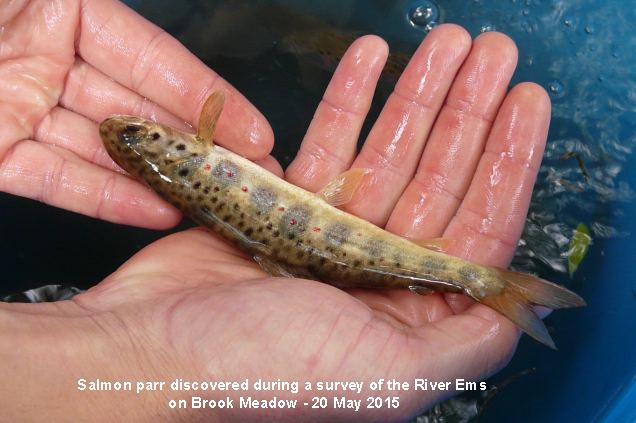
In general Phil
thought the river was in excellent condition, though
some of the overhanging branches needed clearing to
allow more light through to encourage plants in the
river. Their recommendations would be included in the
report to go to David Search.
Water
Vole situation
Jennifer and I
discussed the situation regarding the Water Vole
problem in the river this year with the Environment
Agency chaps. Regarding Pike, they agreed they were
predators, though thought it unlikely they would be
taking full grown voles. This was particularly the
case since the survey indicated the river was well
stocked with Brown Trout and Eels which would provide
a good food supply for the Pike.
They thought last winter's flooding would have had
only a temporary effect on the Water Vole population.
From their experience of other rivers that flooded,
the voles quickly returned once the floods had gone.
So, it seems we have to look elsewhere for the cause
of the Water Vole problem. Although we have never seen
a Mink on Brook Meadow, it was thought to be useful to
set Mink traps to see if they were present.
Mystery
moth is Grass Rivulet
Our
entomologist correspondent Tony Davis came to the
rescue over the identification of the small white moth
that I saw and photographed on Brook Meadow on May
18th.
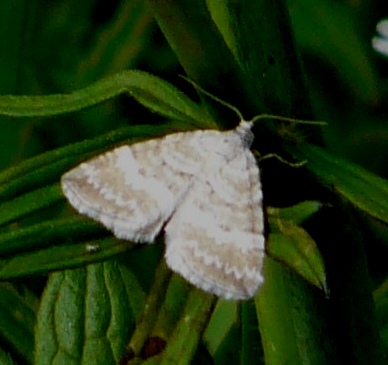
He said both of the
suggestions on last night's blog were incorrect. Tony
said the moth is Grass Rivulet (Perizoma
albulata), the larvae of which feed on the
ripening seeds of Yellow Rattle. That is very
appropriate as we have masses of Yellow Rattle on
Brook Meadow right where I saw the moth. Tony saw
several of these moths at Brook Meadow last year
whilst looking for some of the plants that you
mentioned on the blog!
Details: "May - July. Britain and Ireland. A small
white moth variably marked with grey and brown lines.
Often found near Yellow Rattle and found on grassland,
dune slacks and coastal shingle. Typically the whitish
forewing with extensive grey-brown cross-bands help to
identify this moth. Paler forms can be found in some
calcareous districts. Flies by day, from late
afternoon to early dusk, sometimes in large numbers.
Also flies after dark."
See . . . http://butterfly-conservation.org/51-1358/grass-rivulet.html
TUESDAY
MAY 19 - 2015
One
cygnet lost
All was well
on the town millpond when I checked the Mute Swan
family at 10am this morning. The pen was on the pond
with her 8 cygnets in tow and all were looking good.
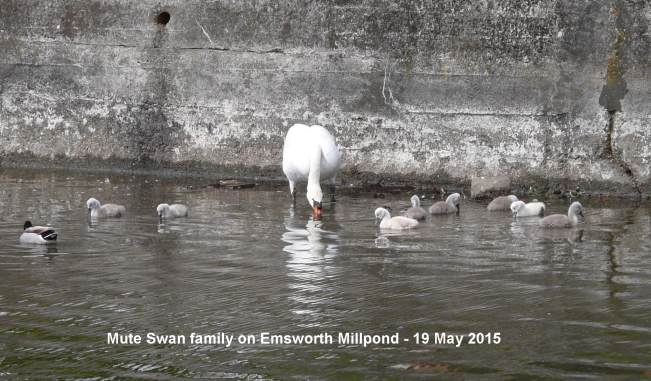
However, I had a visit
from Juliet Walker at about 6pm this evening. She had
just come from the millpond where the cygnets were
down to seven. She was informed by a lady who had seen
what had happened that one of the pale 'Polish'
cygnets had been attacked by a gull and had died in
the attack. It is possible that the gull targetted the
pale cygnet as stood out from the rest. This is
unfortunate, but not unexpected as young birds are
very vulnerable and mortality among them is large.
That is the main reason why many bird species (like
swans) tend to have such large families. I would be
very surprised if other cygnets were not lost in the
next week or so.
Slipper Millpond
Over on
Slipper Millpond a Great Black-backed Gull was
sitting snugly on the nest on the centre raft with no
sign of any hatching activity. My predicted hatching
date is tomorrow!
Two Mute Swans were on Slipper Millpond looking
very much like a pair. So, the cob that lost its mate
a couple of months ago appears to have found himself a
new mate. Let's hope so, though it is too late for any
nesting this year.
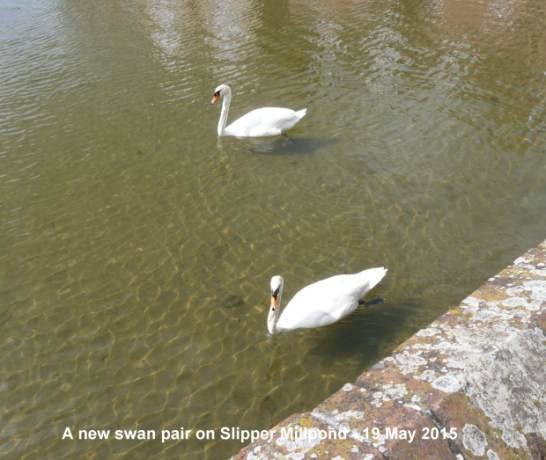
I was disappointed to
see that the nice growth of Lesser Swine-cress
that I found growing against the wall of Chequers Quay
houses near the western gate on May 13th has been
cleared, along with all the other 'weeds'. At least,
they have not been sprayed.
Brook
Meadow
I saw two
people with their dogs walking through the centre of
the orchid area this morning. I shall inform the
conservation group and suggest they erect the
temporary fences around the main area with notices
asking people to avoid walking through this sensitive
area during the flowering season to avoid damaging
delicate plants.
Young
Starlings
It is good to
see the first young Starling of the year in the garden
this morning, just one being fed by its attentive
parents. I hope they can avoid the marauding cats.
Here is the youngster calling from the clematis.
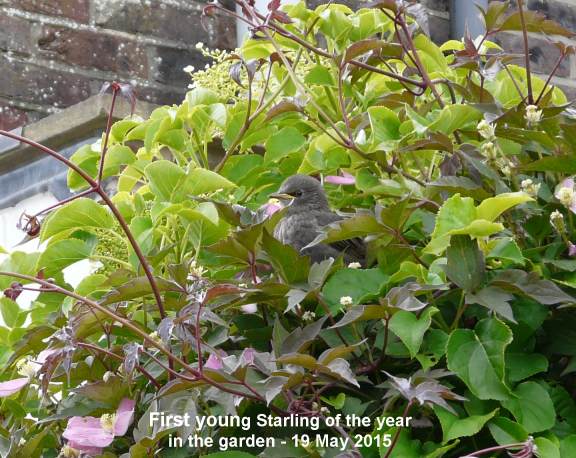
Marlpit
Lane
I parked near
the amenity tip at 12 noon and slowly walked up and
down the lane but did not hear anything of a
Nightingale. I then walked around the wasteland area
to the east of the lane, hearing just one short burst
of Nightingale song from the same bushes that I
heard one on April 23rd. It looks as if this has been
a poor year for Nightingales at Marlpit Lane as only
this single songster has been reported as far as I am
aware. A Whitethroat was singing strongly and a
Cuckoo was calling from a distance, but nothing else
of interest on the bird front apart from a Swallow
flying over.
The only butterfly I noticed happened to be a good one
- my first Common Blue of the year.
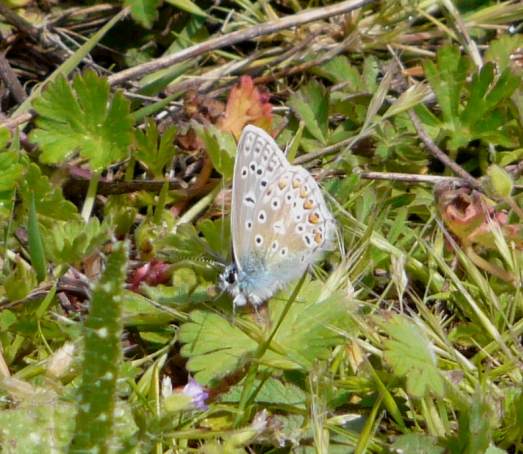
As for wild flowers I
found some new ones coming up on the waste ground
including, Field Madder, Field Forget-me-not, Weld,
Crosswort, Scarlet Pimpernel. It was interesting to
compare Silverweed and Creeping Cinquefoil
at close quarters. They both have very similar
flowers, but quite different leaves.
Silverweed
. . . . . . . . . . . . . . . . . . . . . . . . . .
Creeping Cinquefoil
Hampshire
Farm
I popped into
the Hampshire Farm open space area on my way back from
Marlpit Lane. I parked in the car park, noting the
interesting Willow tunnel structures and several new
pieces of play apparatus. The photo shows one of three
Willow tunnels, still fenced off to allow them to
establiush themselves.
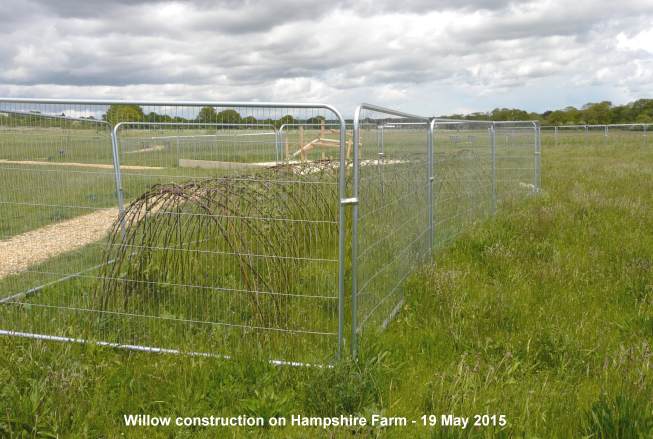
I walked right round
the site including the wilder northern section. I did
not see much in the way of birds. However, the pair of
Shelduck that Chris Oakley previously noted was
still on the pond. I should have thought that one of
the pair would be on the nest if they were nesting
nearby.
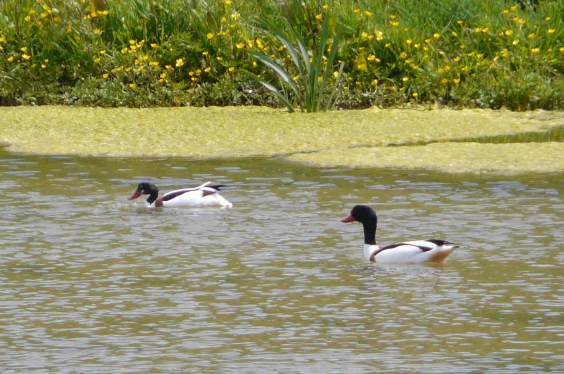
A Pied Wagtail was
feeding on the edge of the pond and a Swallow hawking
over the water. Starlings were very noisy in the
hedges at the north of the site, presumably with
youngsters. I passed a dead and well eaten Fox on the
north west of the site.
The grassland
is mostly a single species, presumably sown when the
land was developed. I am not entirely sure of the
species, but it is almost certainly a Fescue, probably
Red Fescue, though it did vary quite a lot from
one area to another. In parts it certainly lives up to
its name in having very red panicles. Of other
grasses, I also noted Yorkshire Fog (a nice patch in
the northern sector), Cocksfoot and Barren Brome
mostly in the wilder area to the north of the main
site. I think I also noticed some Crested Dog's-tail
which was present in some quantity last year.
I noted down any flowering plants that caught my eye,
without in any sense trying to do a proper survey. I
noted Black Medick, Lesser Trefoil (small clusters of
yellow flowers with notched leaves), Ribwort Plantain,
Oxeye Daisy (just one open), Bulbous Buttercup,
Creeping Buttercup, Meadow Buttercup, Common Vetch,
Wintercress, Field Forget-me-not, Red Clover, White
Clover, Common Mouse-ear, Red Campion, Daisy,
Broad-leaved Dock, Curled Dock, Bird's-foot Trefoil,
Creeping Thistle, Bristly Ox-tongue, Cat's-ear, Common
Ragwort, Beaked Hawk's-beard.
Mystery
moth
Regarding the
identity of the small white moth I saw flying on Brook
Meadow yesterday Ralph Hollins thinks it is likely to
be a Common Carpet (Epirrhoe alternata).
Common in a wide range of habitats, including
hedgerows, woodland, calcareous grassland, acid
heathland, moorland, fens, sand-dunes and gardens
throughout the British Isles. Widespread and common in
Hampshire and on the Isle of Wight. See . . .
http://www.hantsmoths.org.uk/species/1738.php
Eric Eddles suggested it might be Satin Wave
(Idaea subsericeata). Common in woodland,
scrub, hedgerows, rough grassland and gardens
throughout much of southern England, less frequent in
south-western and northern England. In Hampshire and
on the Isle of Wight fairly common locally, on heaths
and amongst tall grasses on downland.
See . . . http://www.hantsmoths.org.uk/species/1709.php
Purely on the basis of likeness to the original I am
inclined to go with Common Carpet.
Here
is the Brook Meadow moth

and
here are Common Carpet Moth and Satin Wave
moth
MONDAY
MAY 18 - 2015
Millpond
News
When I passed
by the town millpond at about 11.30 this morning, the
pen swan was on the water with her 8 small cygnets all
present and correct. The youngsters were all busily
feeding among the leaf litter on the water surface and
are clearly growing in size and looking well.
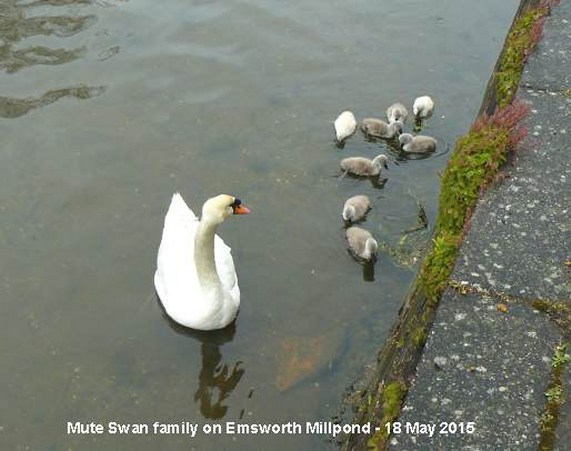
Brook
Meadow
I had a walk
through the meadow after morning rain. This seemed to
have given the flowers a lift.
I found my first Southern Marsh Orchids of the
year, just starting to flower in the usual area on the
north meadow; two plants were close together and a
third nearby. I marked them with twigs. The first
Yellow Rattle flowers are also starting to
open.
I did another count of
Ragged Robin flowering plants and got a total
of 25 with 20 on the Lumley area and another 5 on the
area north of the causeway. That's a good increase
from the 11 just two days ago.
Lesser Swine-cress
(not in flower) is growing on the steps down to
the meadow from the north bridge. I must warn the
conservation group not to clear these steps.
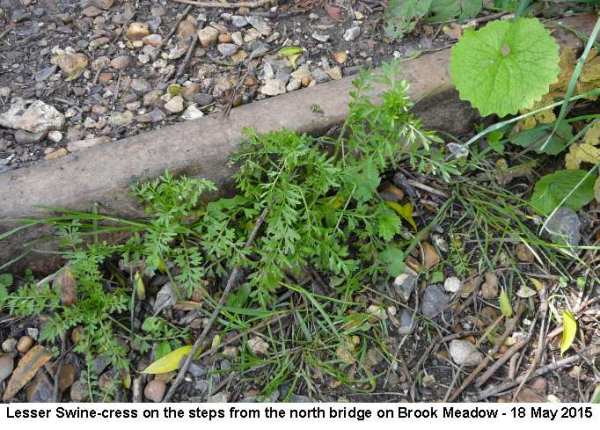
Another three firsts
for the year were Marsh Foxtail in the "Lumley
puddle" area and Common Spike-rush in the area
north of the "Lumley puddle" and Spiked Sedge
on the main Lumley area. I could not find the rare
Slender Spike-rush that John Norton first found in
2012.
I spotted the first 'thigh beetle'
(Oedemera nobilis) of the year on a
buttercup flower. And a small white moth was
flying which came to rest briefly for a photo. I would
appreciate help with the moth ID. My very tentative
suggestion is Mother of Pearl.
See a
summary of the local wildlife news from over the past
two weeks at . . .
Wildlife
News Summaries
SUNDAY
MAY 17 - 2015
Weed
spraying - a rant
One thing that
really upsets me when I walk around the town is seeing
patches of burnt grasses along the edges of pavements
and around trees and lampposts. This is the result of
weed spraying by the Council. Not only is this
practice unecological but it also defaces the town,
leaving ugly scars which take time to heal. And it is
not just Havant that does it, but also West
Sussex.
Jean and I had a walk to Westbourne this morning and
found the edges of the millstream brown and lifeless.
This is, of course, where Water Voles have been seen.
We walked back via Lumley Mill where I had hoped to
see the Greater Celandines on the path towards Seagull
Lane, but I was dismayed to find them shrivelled and
dying. This is the only place in the local area that
these beautiful plants flourish in the wild and they
have been snuffed out. The destruction of interesting
plants is inevitable with indiscriminate spraying.
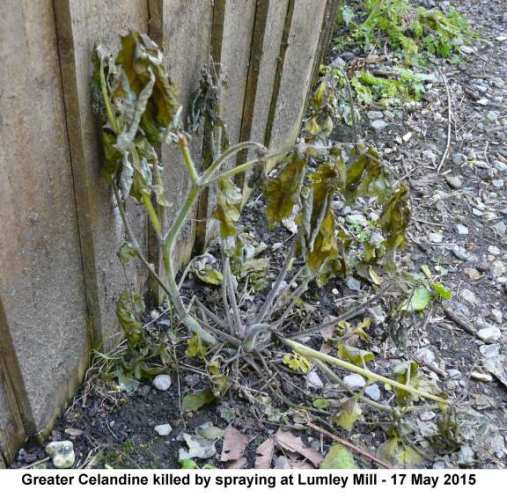
Warblington shore
Peter
Milinets-Raby was on the Warblington shore this
morning from 6:34am to 8:48am with the tide pushing
in. The highlights were as follows:
Cemetery: Goldcrest singing, Green Woodpecker, Med
Gull over north, Male Kestrel
Ibis Field: Chiffchaff heard, Blackcap heard, 4
Swallows east.
Hedgerow behind Conigar Point: Chiffchaff heard,
Cetti's Warbler Heard, Reed Warbler (Heard - 60 metres
away from mini reed bed).
Conigar Point: Reed Warbler heard x2 (mini reed bed),
5 Grey Plover (2 in summer plumage) - flew off south
after 20 minutes with Dunlin), 1 summer plumaged
Dunlin, 2 Shelduck, 2 Med Gull - adult and first
summer.
Pook Lane: 4 Common Tern, 2 Little Tern, 6 Med Gulls
west to Oyster beds, 1 Greenshank - un-ringed, 2
Shelduck, 1 Turnstone in summer plumage, 3 Swallow
east.
Langstone Mill Pond: Mute Swan - 2 adults with 7
cygnets left at 7:20am and walked across the mud to
the pond outflow stream - stayed here until 8:35am
when they headed off to the Hayling Bridge. Reed
Warbler - Heard x2, Cetti's Warbler heard, Reed
Bunting heard, Male & female Tufted Duck, Two Coot
families - one with 2 young and another with five,
House Martin - single over.
Grey Heron colony: Fifth nest - 2 adults feeding 3
very tiny young, Sixth nest - 2 adults feeding 2 very
tiny young.
SATURDAY
MAY 16 - 2015
Mute
Swan news
The resident
pair of Mute Swans were on the pond when I passed by
at about 11am this morning with all 8 cygnets still
present. Aren't they doing well!
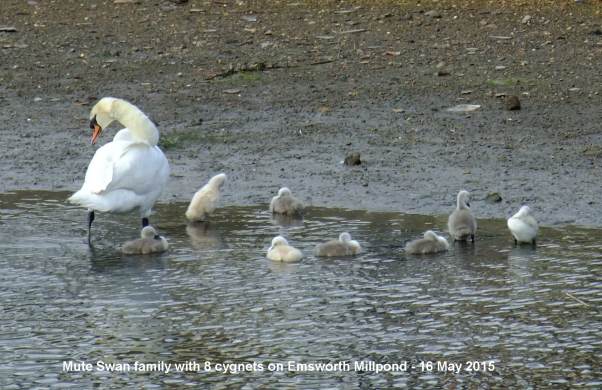
Ragged
Robin
I spent the
whole afternoon on the meadow updating the three
signcases with new photos. While there I counted 11
Ragged Robin plants in flower on the Lumley area,
which is a good increase from the one 3 days ago on
May 13th. Is this going to be a good year? Here is one
of them. You can see how the plant gets its name.
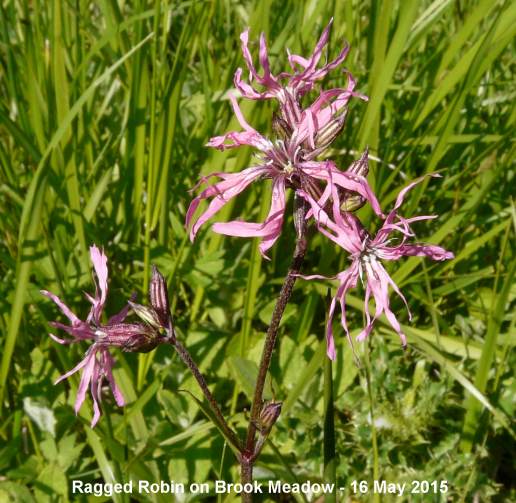
Baffins
Pond
The Irons
family was at Baffins Pond again today. Young Thomas
got photos of the swan family with 3 cygnets and a
Coot feeding two older chicks.
South
Hayling
Ros Norton
reported on this morning's walk by the Havant Wildlife
Group - including some pretty special plants:
Go to . . . http://familyfellows.com/hwg-index.htm
Click the 2015 reports.
FRIDAY
MAY 15 - 2015
Millpond
News
The resident
pair of Mute Swans were on the pond when I
passed by at about 11am this morning with all 8
cygnets still present and looking healthy. The parents
were puddling up the mud at the bottom of the pond
with their feet to release bits and pieces of
foodstuff for the cygnets.
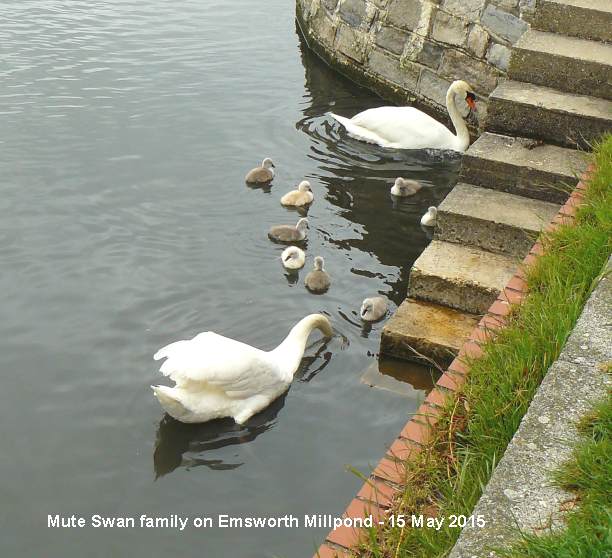
Over at Slipper
Millpond one Great Black-backed Gull was
sitting on the nest on the centre raft while its mate
was in the water nearby, seeing off any gulls that
came too close. Hatching time is getting nearer - my
estimate is May 20th.
Meanwhile on Peter
Pond, the lone cob Mute Swan that lost its mate
a few weeks ago appears to have a companion. A second
swan, probably a female, was nearby and significantly
not being driven off. Romance is in the air!
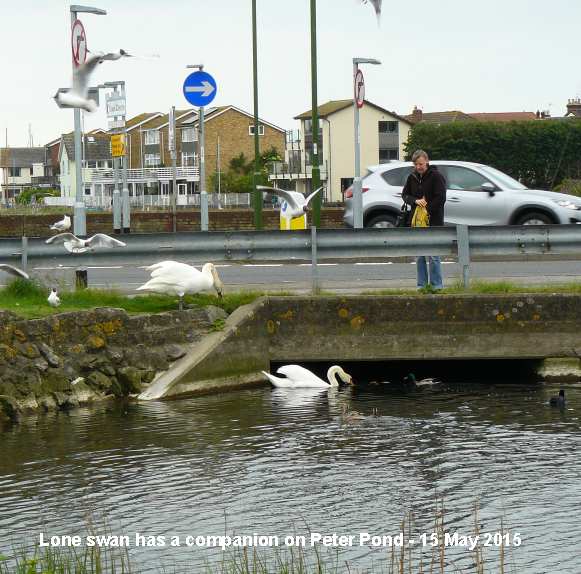
I had my first
Goat's-beard flower of the year on the south
side of Peter Pond near the main road. The yellow
florets are markedly shorter than the long pointed
bracts. This plant is also known as
'Jack-go-to-bed-at-noon' from the habit of the flowers
of only opening in the morning sunshine. Goat's-beard
has a large and conspicuous 'clock' seedhead.
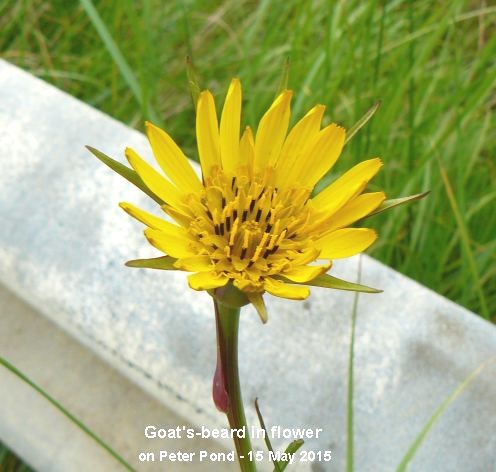
Walking up the path
towards Gooseberry Cottage I could hear the Reed
Warbler singing in the reeds at the north of Peter
Pond and the regular Whitethroat in the bramble
hedge.
North
Thorney
I cycled down
to North Thorney and at the bottom of the slope
towards the western track I found a good tuft of
Spiked Sedge. This is a fairly common sedge,
though is easily confused with False Fox Sedge. But ,
False Fox Sedge is generally a much larger plant with
stouter stems, broader leaves and a thicker
inflorescence. I have included a photo of the two
inflorescences for comparison. The Spiked Sedge on the
left was from North Thorney and the False Fox Sedge
(in flower) from the wayside north of Emsworth Railway
Station.
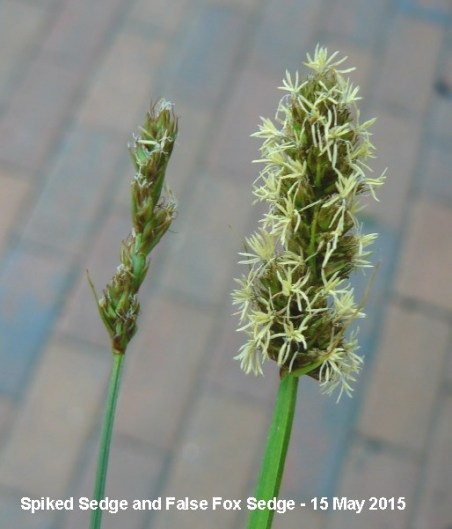
The red flower spikes
of Sheep's Sorrel are very prominent on the
left hand side of the track towards Little Deeps. This
is a smaller plant that the more common Sorrel with a
more open flower spike. It has distinctive leaves with
basal lobes pointing sideways or forwards. It also has
a slightly different habitat to Common Sorrel,
preferring drier, heathy places with bare soil. It is
a native perennial plant.
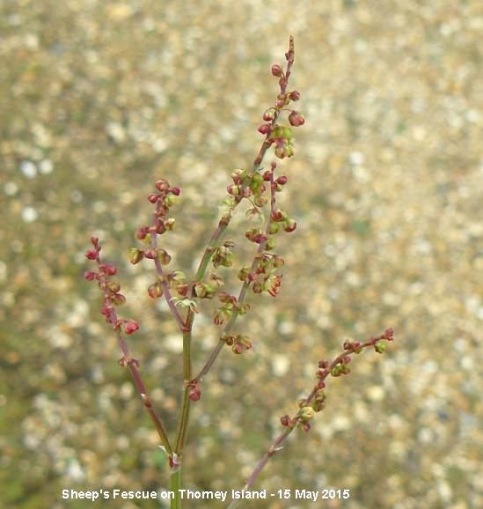
Rook
in garden
I had a call
from my wife this afternoon from the kitchen that we
had a crow on the bird table. That was good news as
crows are quite rare birds in the garden. However,
when I arrived at the kitchen window I could see
immediately that the bird in question was a Rook - a
first for our garden. The Rook stayed on the bird
table for a few minutes taking seeds and chopped
peanuts that I leave out for the birds. I approached
the window with my camera very cautiously and managed
to get a few shots of the bird before it flew off.
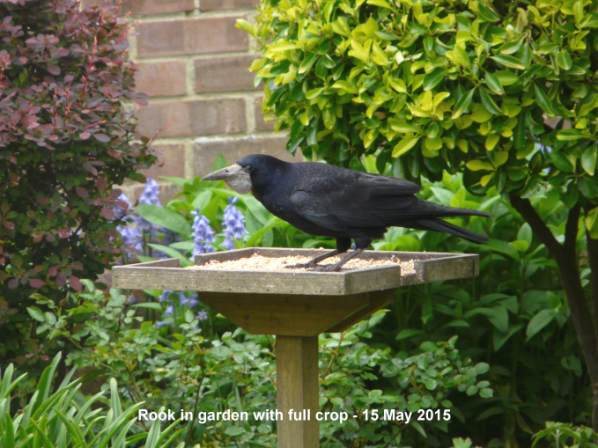
As can be seen from
the photo, the Rook had a bulging crop, presumably of
seeds and nuts to take back to the nest for hungry
youngsters. The nearest Rookery to my house in Bridge
Road is about half a mile away, in the tall trees
behind the flats opposite the entrance to Emsworth
Primary School in Victoria Road. That is not a great
distance for a Rook to fly, but quite a surprise to
see it here. There are quite a few similar photos on
the internet of Rooks with full crops.
See . . . http://www.arkive.org/rook/corvus-frugilegus/image-A12636.html
Rook stands 25th in
the BTO Garden BirdWatch list for this time of the
year and in this area of the country. It is reported
by 15% of the participants in the survey. But it was a
first for me!
THURSDAY
MAY 14 - 2015
Mute
Swan news
I walked down
to the town millpond this afternoon after the worst of
the rain had finished. The pen swan was on the water
with her 8 cygnets still all present and healthy. The
mother swan was stirring up the mud at the bottom of
the pond with her feet to dislodge any protein rich
food for her youngsters. They are clearly starting to
feed. The cob was nearby on guard, but not really
needed.
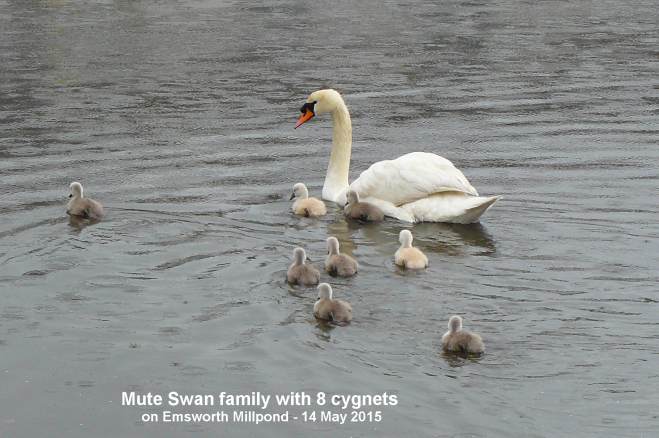
PS - Eric Eddles tells
me that the swan pair on Baffins Pond Portsmouth now
have three cygnets.
Cow
Parsley
Coming back
home through Brook Meadow it gave me great pleasure to
push my way through the overhanging panicles of Cow
Parsley that now line the main raised paths. It is one
of the great Brook Meadow spectacles at this time of
the year.
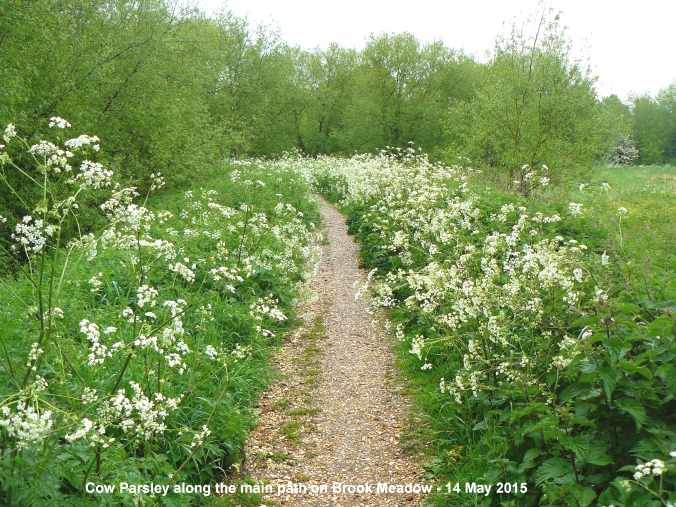
Young
Woodpigeon
We had the
first young Woodpigeon of the year in the garden
today. It differs from the adult mainly in the absence
of the white collar. It also has dark eyes, not
clearly seen in this photo; the adult has pale yellow
eyes.
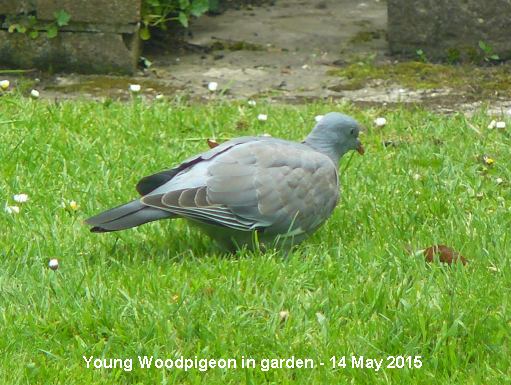
Francis's news
Francis
Kinsella had a walk through the fields between
Emsworth and Westbourne yesterday and got a couple of
excellent bird photos. On the left is a male Linnet
showing its red breast markings. On the right is a
male Green Woodpecker with red moustache
(female has no red moustache).
Francis also got this
slightly unusual shot of what must be a female
Blackcap on Brook Meadow.
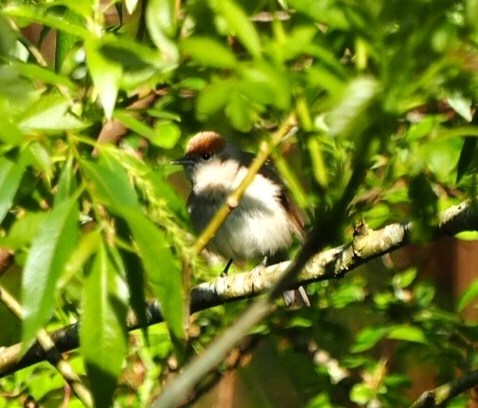
Reed
Bunting and bee
Tony Wootton
was trying to get a shot of a Reed Bunting when it
flew off. It was only when he got home and on the
computer that he noticed the presence of a bee. In the
first photo the bird is looking at the bee and in the
second it is trying to catch it.
Tony asks, Would a
reed bunting try and eat a bee? According to my book
Reed Buntings eat seeds plus insects in summer, so a
bee would seem to be an appropriate prey. I checked
with the BWP which says Reed Bunting commonly catches
flying insects, especially Odonata and Diptera, in
sallies from perch. but does not mention bees
specifically. However, with youngsters in the nest
demanding high protein food, then a juicy bee would
clearly be in order.
Hot
Sardines
Having a
snooze after a long cycle ride to Portsdown Hill
yesterday, Ralph Hollins was woken by a lively jazz
group called Hot Sardines singing "I wanna be like
you" in French on Radio 3. Ralph was so taken with the
group that he felt compelled to recommend their songs
to others as "they will take 50 years off your actual
age and revive your youth in a way that the NHS
cannot". See . . . http://ralph-hollins.net/Diary.htm
Well, that is some claim, so, on a very cold and wet
morning, Jean and I followed Ralph's advice and spent
a wonderful hour or so enjoying this lively group on
the YouTube video. We hardly danced around the room,
but at least we bounced and rocked in our armchairs!
The lead track is excellent (particularly if you are a
fan of Jungle Book), but make sure you don't miss the
black and white video with Ralph's Miss Elizabeth with
her washboard strapped to her bosom! Priceless.
Go to . . . https://www.youtube.com/watch?v=kXd9drHdkw4
Cuckoo
migration
The BTO
reports that Cuckoo migration is going well. Four
years and 55,000 miles after he was first fitted with
a satellite tag, Norfolk Cuckoo Chris has once again
returned to the UK, along with eight other
satellite-tagged Cuckoos which are all back on their
breeding grounds. See . . . http://bto-enews.org/IG4-3DTSH-3RN36S-1LC6C1-0/c.aspx
For
earlier observations go to . . May
1-14